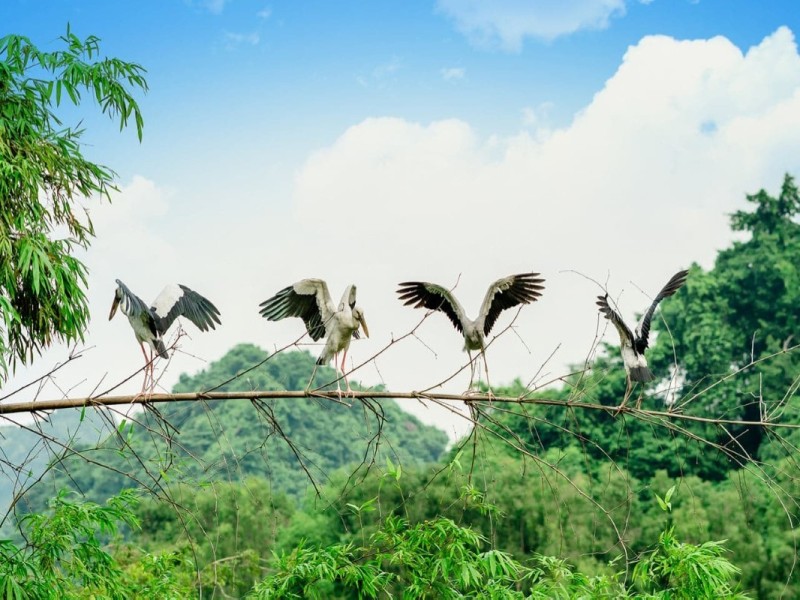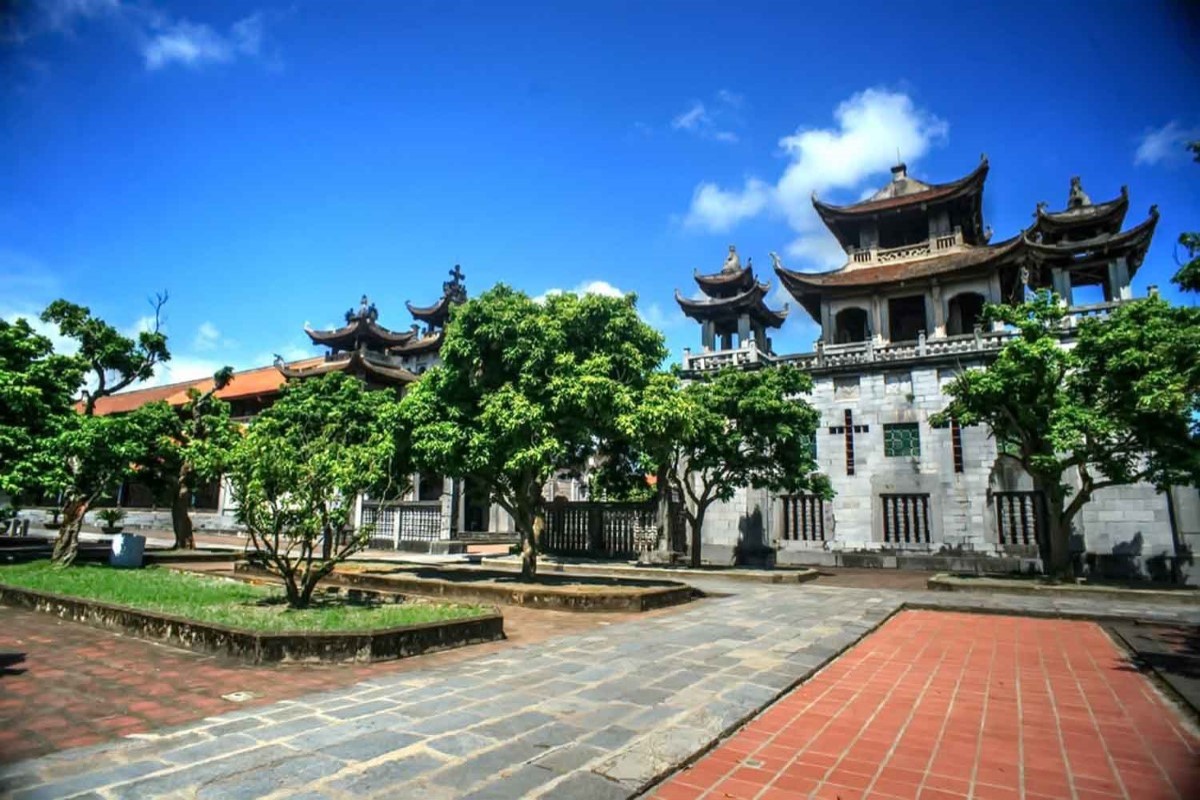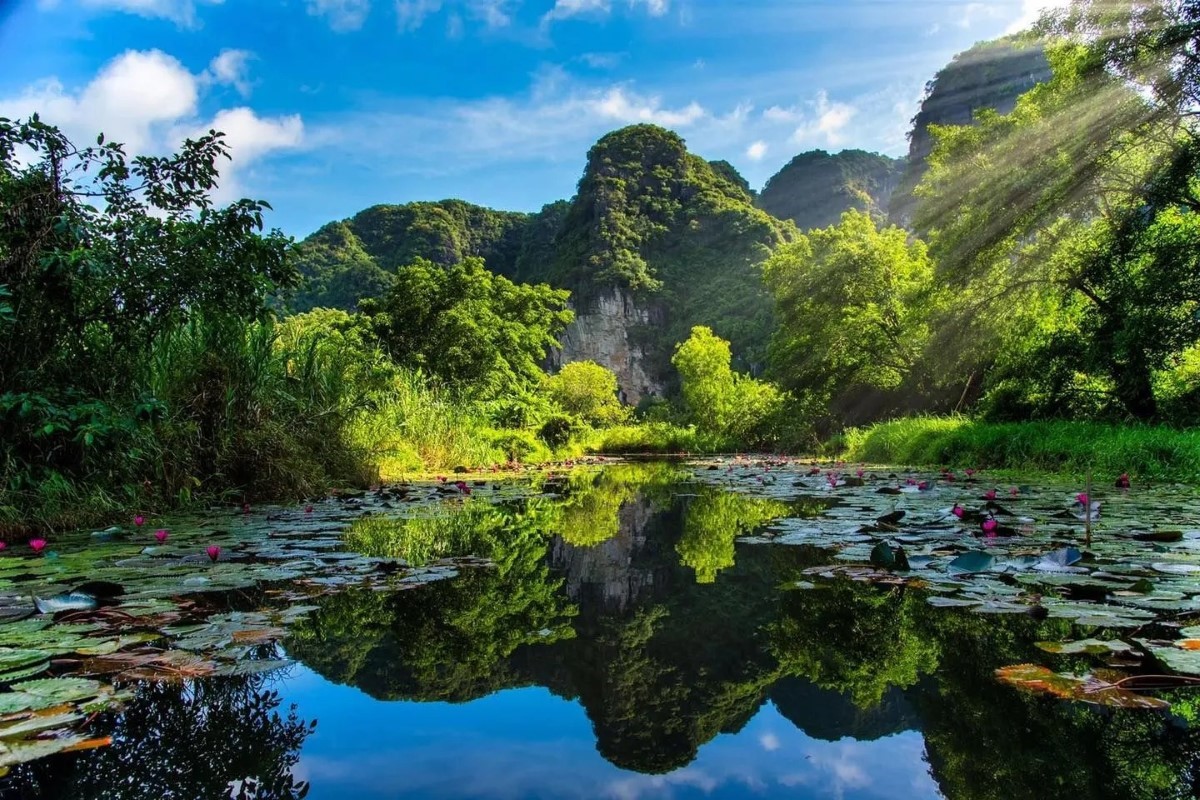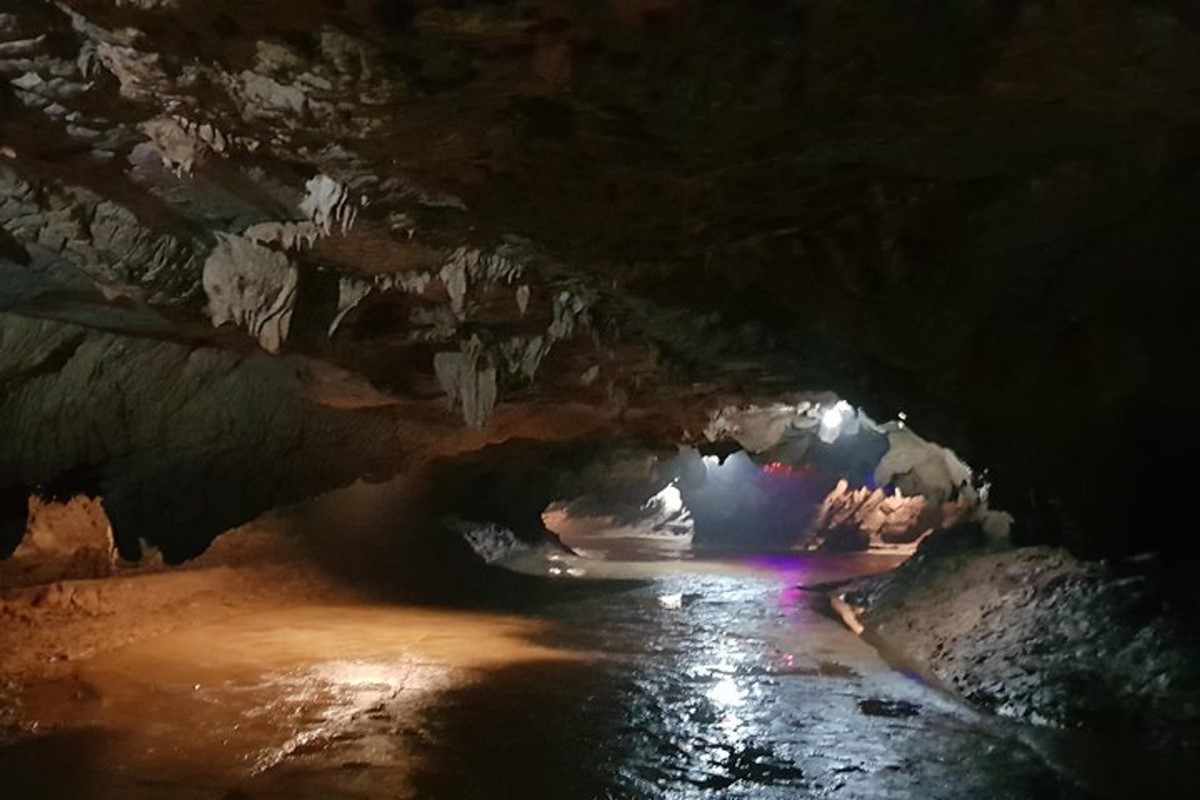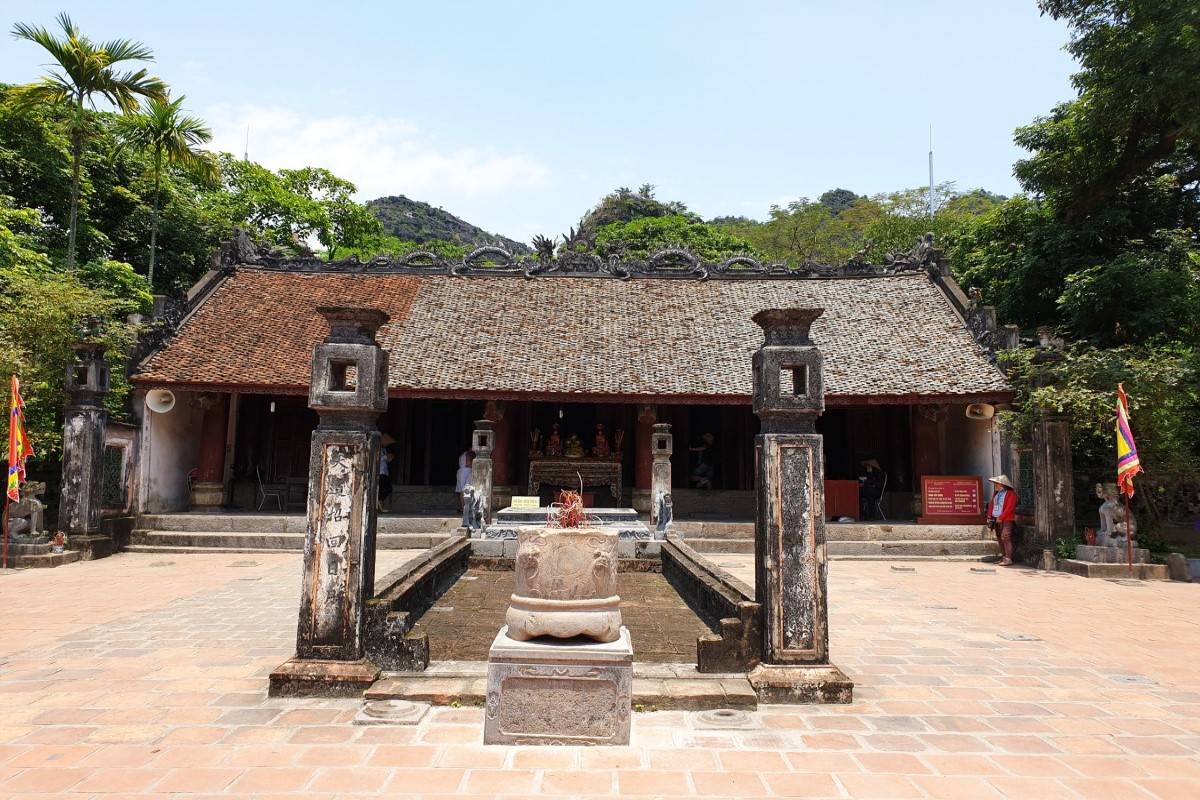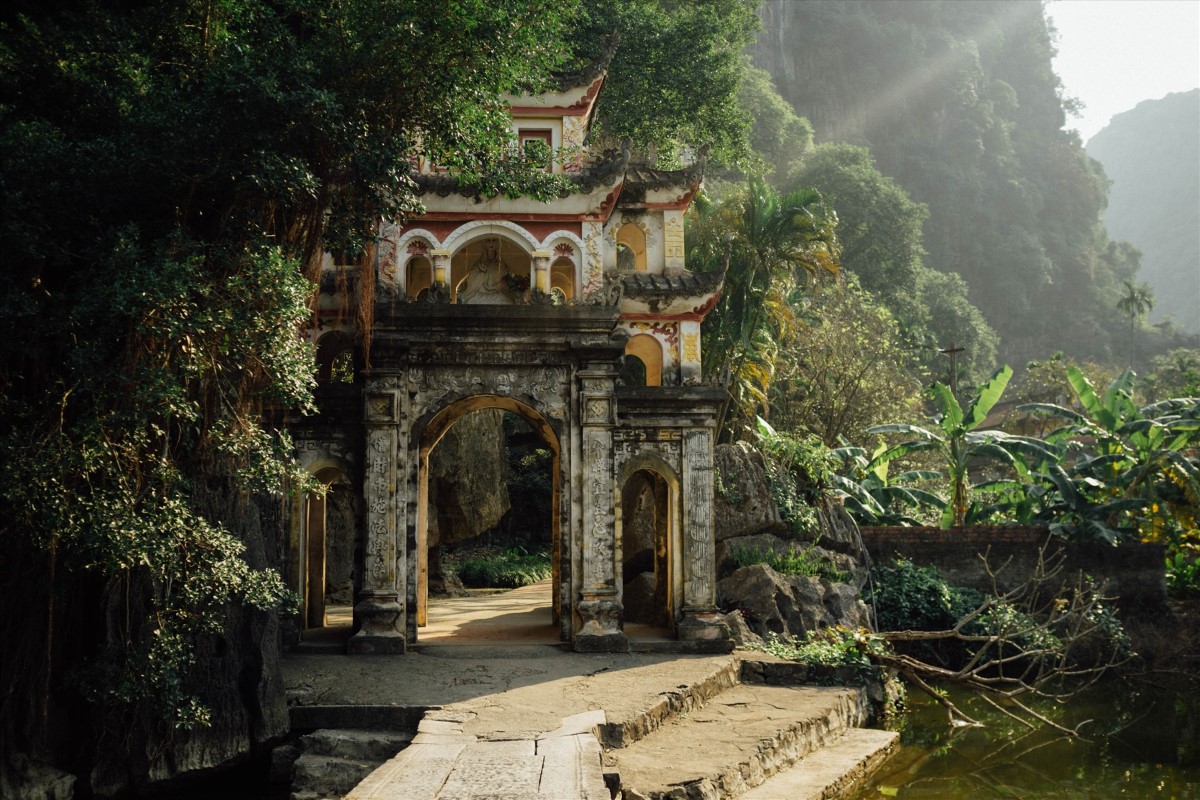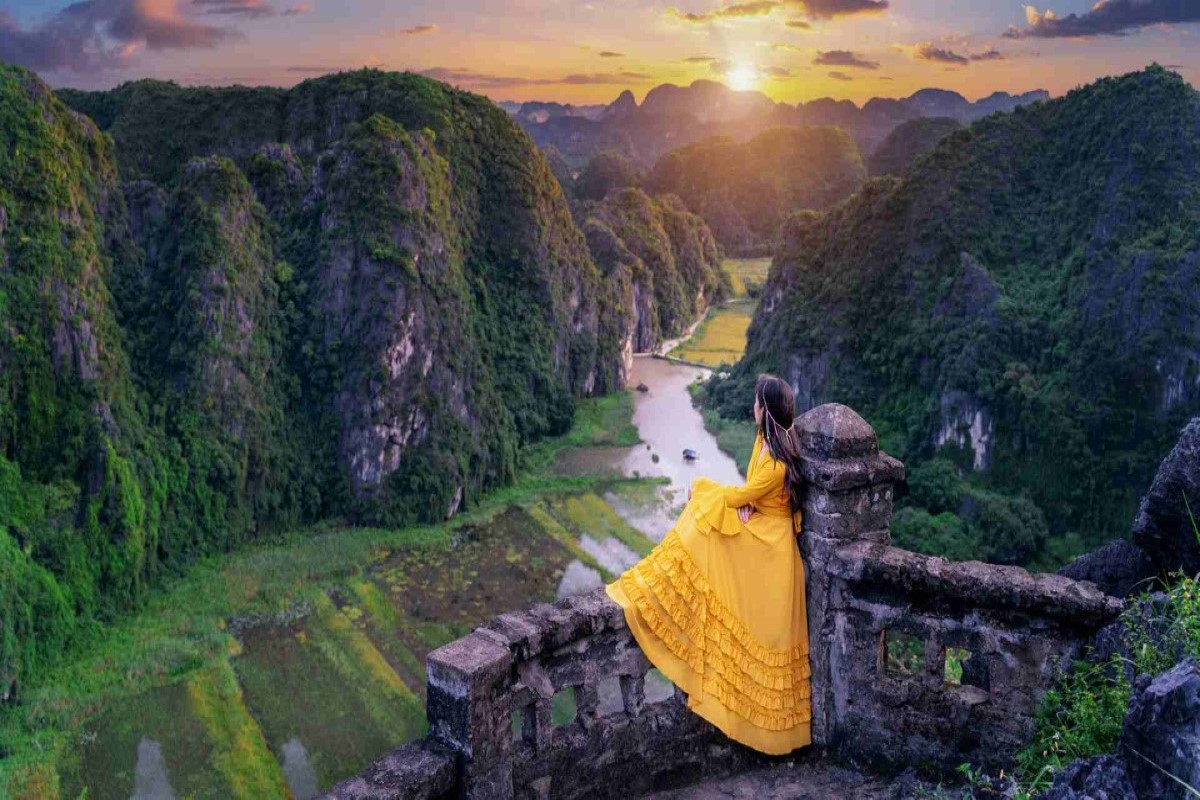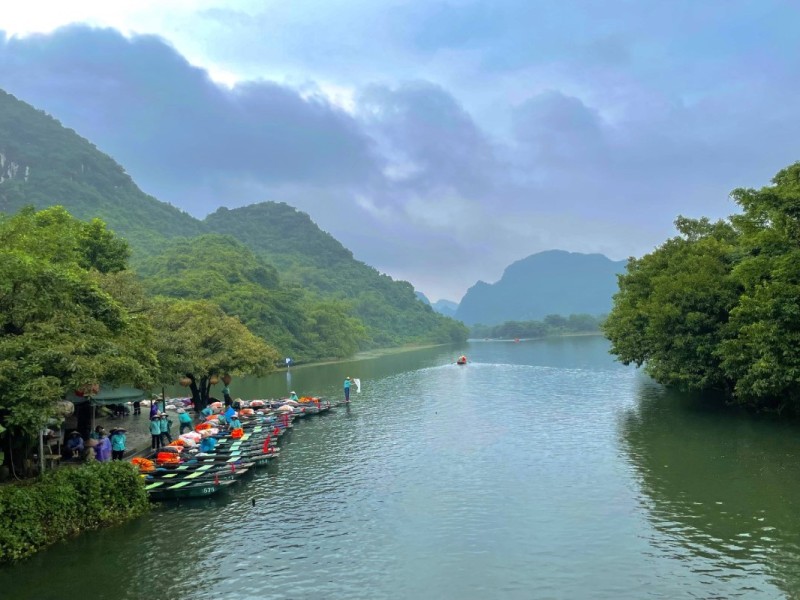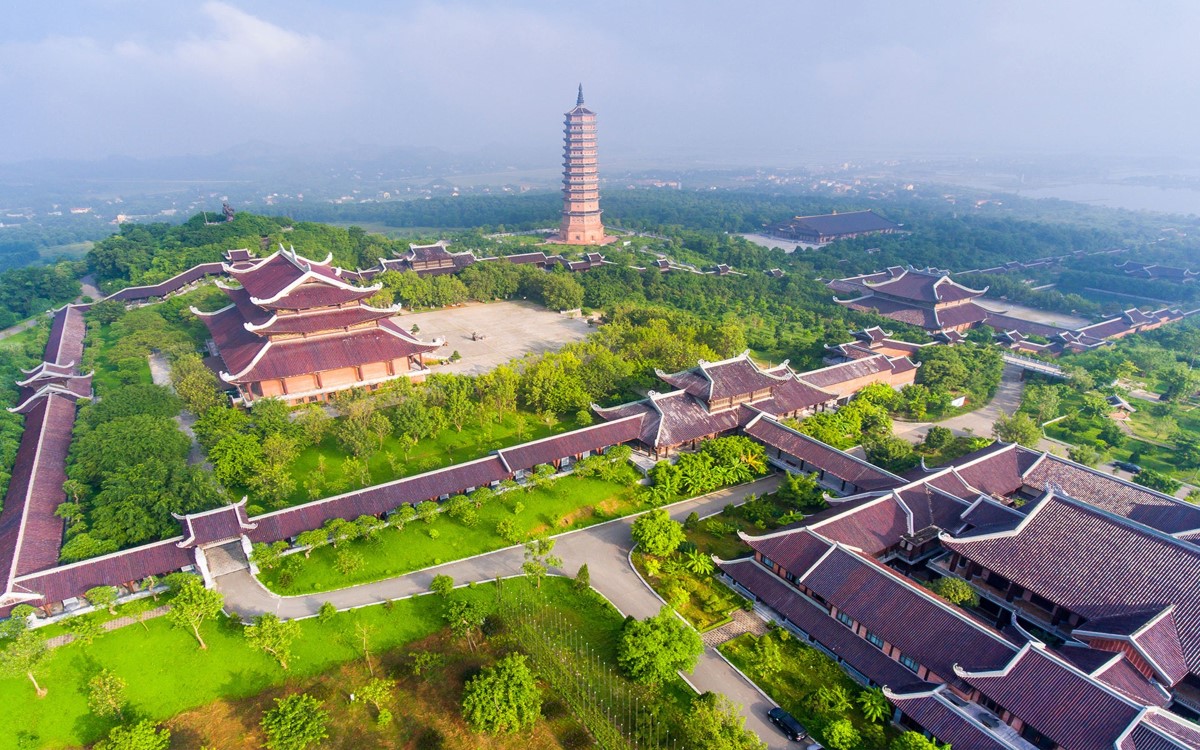Van Long Nature Reserve Ninh Binh: Complete Travel Guide
Van Long Nature Reserve is a serene wetland in Ninh Binh, offering peaceful bamboo boat rides, stunning limestone landscapes, and the chance to see rare species like the Delacour’s langur. Known for its untouched beauty, it provides a quiet alternative to more crowded destinations in northern Vietnam.
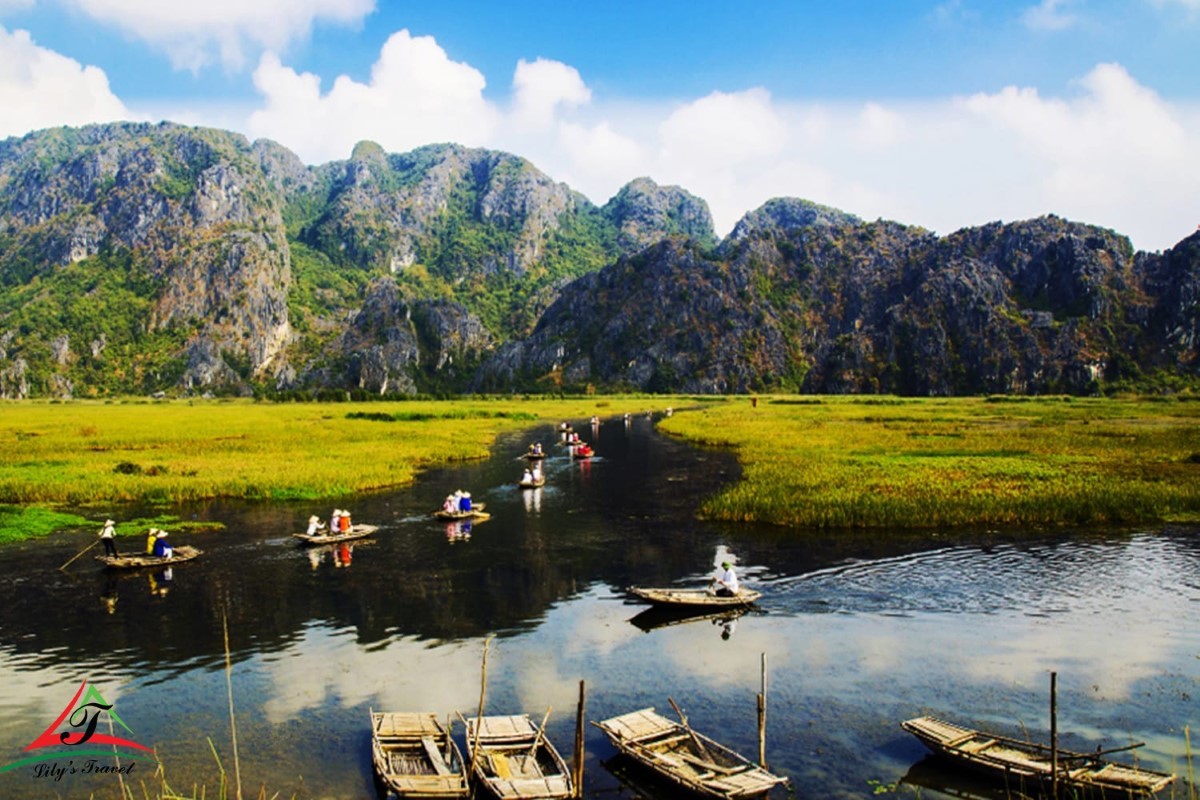
What Makes Van Long Nature Reserve Ninh Binh So Special?
Nestled quietly in the heart of northern Vietnam, Van Long Nature Reserve Ninh Binh is a rare sanctuary where time seems to slow and nature takes center stage. Unlike its more commercial neighbors, this vast wetland draws you in not with grand fanfare, but with whispers of mist over calm waters, reflections of jagged limestone peaks, and the flap of a bird's wings echoing across stillness. It's a place that speaks in subtleties—where each paddle stroke on a bamboo boat reveals something sacred and serene. Whether you're a traveler seeking quiet, a photographer chasing golden light, or a family in search of meaningful moments, Van Long offers an experience that resonates deeply and lingers long after you leave.
For those drawn to immersive nature escapes, this is more than just a stop on a Ninh Binh itinerary—it's a heartfelt invitation to reconnect with Vietnam’s untouched soul.
If you’re searching for peaceful beauty and meaningful travel, Van Long Nature Reserve Ninh Binh is ready to welcome you.
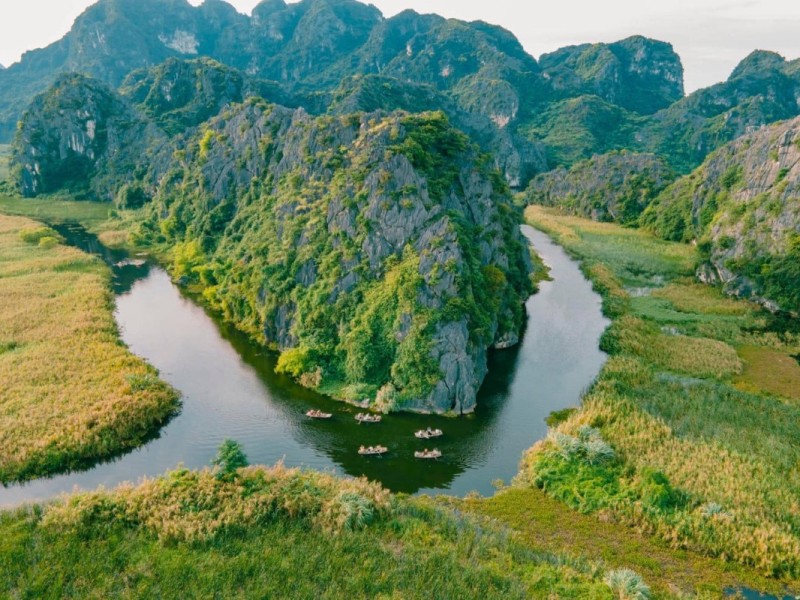
Vietnam’s Hidden Inland Wetland Gem
If you’re wondering how to get to Van Long Nature Reserve from Hanoi, rest assured it’s an easy 2-hour journey south by road—a scenic ride through rice fields and lowland villages. Knowing the best time to visit Van Long Nature Reserve can enhance your trip: the dry season from November to April offers ideal birdwatching and boat rides under clear skies, while lotus season from May to June bathes the wetlands in pink blooms.
Unlike many well-known tourist spots, Van Long remains a well-kept secret. As the largest inland karst wetland Vietnam has to offer, it spans over 3,500 hectares of submerged fields, soaring limestone formations, and thick reed beds. These natural features not only shelter rare species but also support sustainable Ninh Binh eco-tourism.
It’s this harmony between rugged geography, rare wildlife, and the rhythms of rural life that makes Van Long an authentic alternative to commercial hotspots.
Planning ahead ensures you get the most from your visit—pack your camera, your curiosity, and perhaps a pair of binoculars for spotting langurs.
Largest wetland nature reserve in Northern Vietnam
This reserve is more than beautiful—it's vast and vital.
- 3,500 hectares of preserved wetland: The largest of its kind in the north, offering a haven for wildlife and water-based ecosystems.
- Part of the Ramsar Convention network: Officially recognized as a globally important wetland since 2020.
- Home to the rare Delacour’s langur: One of the world's most endangered primates, often spotted clinging to limestone cliffs.
- Crucial bird migration stopover: Hosting hundreds of resident and seasonal bird species.
- Low-impact tourism model: Supports conservation through responsible visits and local employment.
Its ecological richness and protected status give Van Long national and international importance—this isn’t just a wetland, it’s a living landscape of global value.
Take a moment here not just to see, but to appreciate how nature and community intertwine to protect a fragile ecosystem.
Stunning limestone karsts, caves, and tranquil waters
Nature unfolds here in quiet spectacle.
- Jagged limestone peaks: Rising dramatically from still waters, they form natural cathedrals sculpted by time.
- Over 30 caves to explore: Each with its own name and mystery—Ca Cave, Bong Cave, and Turtle Cave among them.
- Glass-like water surface: On calm days, the reserve becomes a mirror reflecting the sky and cliffs in perfect symmetry.
- Flourishing aquatic vegetation: Lotus flowers and reeds sway gently, cradling the boats and hiding small fish and frogs.
- A haven of silence: No motorboats, no crowds—just the gentle rhythm of paddles and birdsong.
Framed by Vietnam’s lush countryside, this is where you’ll find peace in movement, stillness in motion, and a deeper connection to the land.
Let your senses wander as you drift through Van Long’s breathtaking scenery—there’s magic in the simplicity.
A serene alternative to the busy Trang An and Tam Coc
For many travelers, Trang An and Tam Coc are familiar names—but their fame comes with foot traffic and long lines.
- Low visitor volume: Van Long offers intimacy where others feel overwhelming.
- No engine noise: Bamboo boats are rowed by hand, preserving the natural soundscape.
- Wildlife spotting, not just sightseeing: More likely to see langurs and rare birds here than at busier sites.
- Uncommercialized environment: Fewer souvenir stalls, more authentic landscapes.
- Flexible exploration options: Stay longer, linger in silence, or time your visit for golden hour peace.
If you’ve ever wished for a quieter version of Ninh Binh’s beauty, Van Long is it. It’s not about ticking boxes—it’s about fully experiencing what travel is meant to be.
Choose Van Long for a moment of calm in your Vietnam journey—this quiet wetland will stay with you long after the ripples fade.
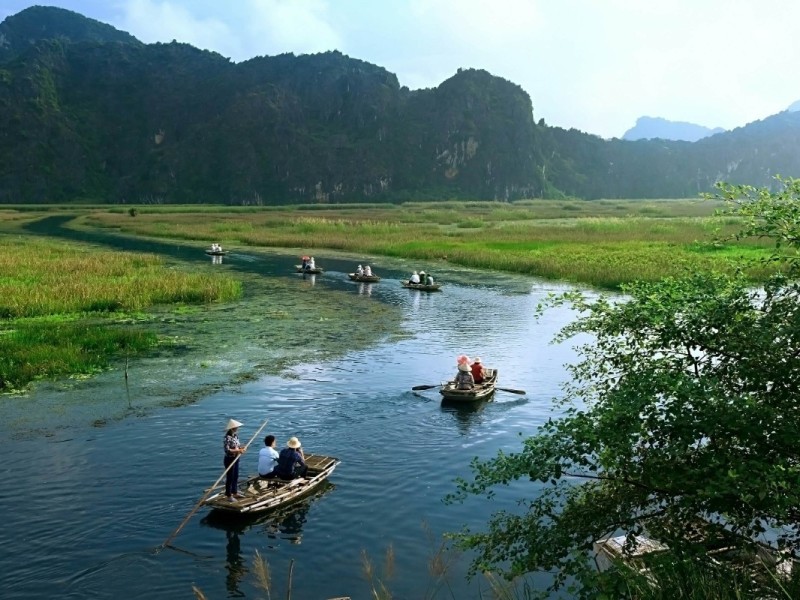
Home to Rare and Endangered Wildlife
If you're dreaming of a quiet escape rich in biodiversity, Van Long wildlife spotting is one of the most rewarding experiences in northern Vietnam. The reserve is a living habitat for many rare species, including the elusive and critically endangered Delacour’s langur, which thrives here in one of the last safe refuges on Earth.
This vast wetland isn't just a scenic wonder; it's a vital conservation zone. As a protected inland marsh, it shelters a balanced ecosystem of water birds, shy primates, and aquatic plants that rely on its stability. The area is one of the last strongholds of Delacour’s langur habitat, where quiet observation and respectful tourism help protect their future.
Nature lovers and photographers often visit not just to admire the scenery, but to catch a glimpse of life that exists nowhere else.
Discover the quiet thrill of nature unfolding in front of you—Van Long’s wild heart is waiting.
Largest population of Delacour’s langur in the wild
This reserve is globally significant for its role in protecting endangered species.
- 200+ individuals recorded: Van Long hosts the largest remaining population of Delacour’s langur in the wild.
- Cliffside living primates: These black-and-white leaf monkeys live high on limestone karsts, often visible in the early morning.
- Critically endangered status: Fewer than 300 remain globally, with Van Long offering their last major sanctuary.
- Nocturnal and cautious: They are shy and fast-moving, making each sighting a rare reward.
- Protected through ecotourism: Local guides help monitor and safeguard their territory.
Spotting a langur in its natural home is a humbling reminder of what we stand to lose—and why responsible tourism matters.
Keep your eyes trained on the cliffs—you might witness a living miracle.
Over 100 bird species including storks, herons, and migratory flocks
Birdwatchers, bring your binoculars—Van Long is a hidden paradise for avian life.
- Diverse waterbirds: Expect elegant herons, cormorants, and kingfishers gliding across wetlands.
- Seasonal migrations: The reserve welcomes flocks from northern Asia during winter months.
- Storks and ibises: Large wading birds forage among reeds and rice paddies.
- Early morning activity: Dawn is the best time to catch vibrant movement and song.
- Birds in flight: Tranquil waters mirror their reflection in picture-perfect moments.
With over 100 species recorded, every visit offers the chance to see something new and beautiful.
Let the skies above Van Long guide you into a quieter, richer world.
Unique flora in protected swamp and karst ecosystems
The biodiversity here isn't only about animals—the flora tells its own story.
- Lotus blooms in summer: These iconic flowers fill the wetland with color and fragrance.
- Dense reed beds: Crucial for bird nesting and ecosystem stability.
- Aquatic rice grass: A food source for fish, birds, and frogs.
- Karst cliff vegetation: Hardy shrubs and vines thrive on limestone outcrops.
- Endemic plant species: Found only in this wetland region of Vietnam.
Together, these plants form the green foundation that supports every living creature here.
Explore this balance of water and earth—Van Long’s flora quietly sustains all who call it home.
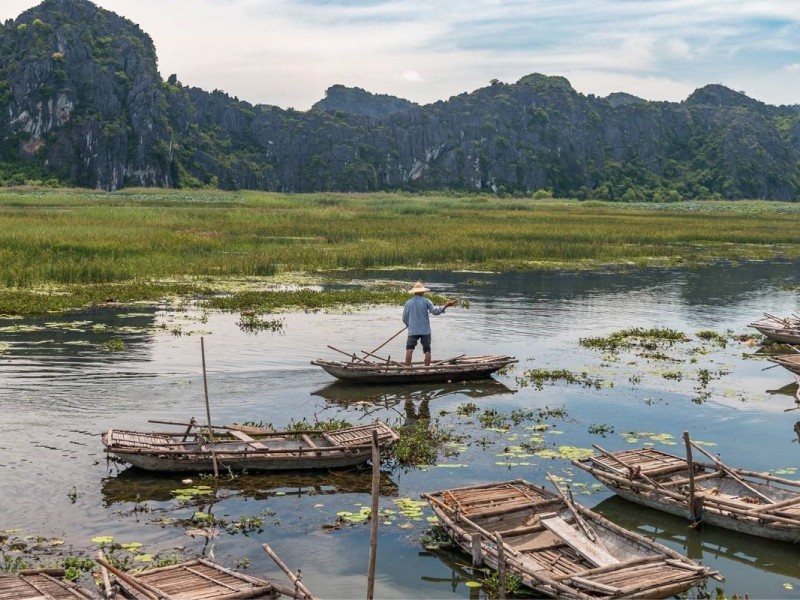
A Ramsar Site With Global Recognition
Few places in Vietnam carry the conservation prestige of Van Long Nature Reserve Ninh Binh. Recognized as one of the critical Ramsar sites in Vietnam, Van Long is globally acknowledged for its ecological importance, particularly as an inland wetland sanctuary supporting rare biodiversity and unique limestone formations.
This status isn't symbolic—it enforces international protection standards and underscores the site's contribution to wetland conservation in Vietnam. Visitors contribute to awareness and preservation simply by coming, learning, and engaging respectfully with this fragile ecosystem.
Understanding Van Long’s global significance helps us travel not just as spectators, but as stewards of natural heritage.
Officially listed as Vietnam’s 9th Ramsar wetland since 2017
Van Long earned its place on the world stage through years of quiet protection and ecological value.
- Ramsar designation year: Recognized as a Ramsar Wetland of International Importance in 2017.
- 9th official listing for Vietnam: Joins a global network of protected wetlands.
- Unique inland wetland status: Unlike coastal wetlands, Van Long represents rare inland karst ecosystems.
- Backed by scientific studies: Research confirms the site's biodiversity and water regulation functions.
- Ongoing monitoring and management: Conservation strategies are updated regularly in line with Ramsar protocols.
Its protected status reinforces why this natural treasure deserves mindful exploration.
Visiting Van Long is stepping into a site globally acknowledged for its irreplaceable ecological role.
Vital habitat for wetland conservation and environmental education
Van Long is not just a wildlife haven—it’s a living classroom and conservation model.
- Educational programs: Local schools and universities use the reserve for ecology and biology lessons.
- Youth involvement: Environmental clubs conduct clean-up drives and observation days.
- Habitat restoration: Ongoing efforts include replanting reed beds and monitoring water quality.
- Community awareness: Tours often include conservation messaging by local guides.
- Eco-tourism model: The reserve showcases how tourism and preservation can coexist.
Van Long brings science, community, and nature together in one shared purpose.
Come see how environmental action flourishes when people and place move in harmony.
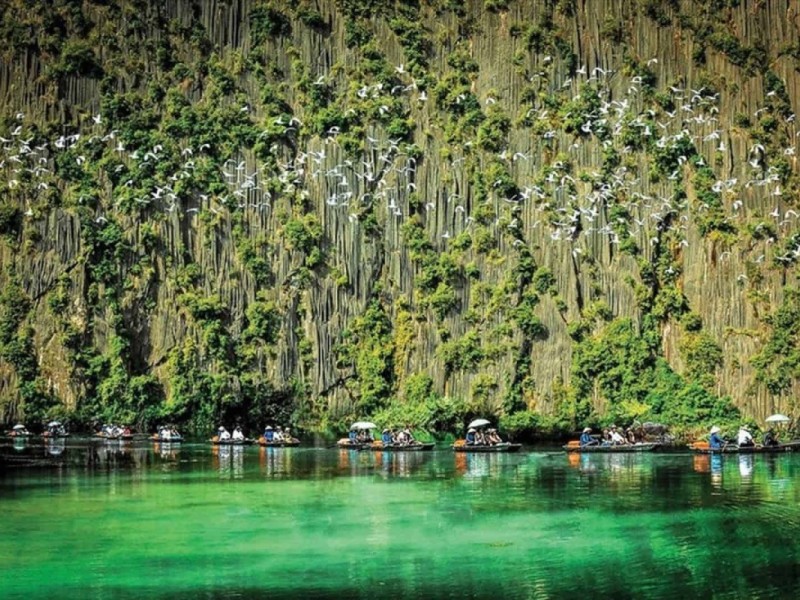
The Van Long Experience: What to Expect
If you're wondering what a visit to Van Long Nature Reserve Ninh Binh really feels like—or what the Van Long boat tour cost might run you—expect a journey marked by quiet, connection, and calm. Tickets are remarkably affordable, typically under 100,000 VND per person for a boat ride, offering one of the most budget-friendly entrances into Ninh Binh eco-tourism.
From the moment you step into the rustic boat station, time begins to slow. A local rower, often a soft-spoken woman from the surrounding village, gently guides the wooden craft across glassy water. There are no motors here—only the rhythmic dip of oars and the echo of distant bird calls bouncing off limestone cliffs.
This is not just a ride. It's a sensory reset. As you pass lush reeds and sunlit caves, a sense of stillness settles in. You feel suspended between water and sky, part of a living postcard—unhurried, untouched, unforgettable.
To make the most of this tranquil wetland boat ride, come early in the morning or near sunset, when the light turns golden and the wildlife becomes most active.
The magic of Van Long unfolds slowly, but deeply—leaving you not just impressed, but profoundly refreshed.
The Tranquil Atmosphere and Serene Landscape
Van Long's allure lies in the silence between ripples and the landscape that seems drawn in watercolor.
- Still water mirrors: The calm wetland surface reflects the towering karsts with near-perfect clarity.
- Gentle rowing pace: Boats glide slowly, letting every moment linger and unfold.
- Unspoiled natural rhythm: You'll hear birdsong, rustling reeds, and the occasional splash of fish—nothing more.
- Shifting light play: As clouds pass or the sun shifts, the cliffs and caves seem to change color before your eyes.
- Immersive solitude: Often, you'll see more birds than people—an increasingly rare gift in travel today.
This quiet, immersive setting makes Van Long not just a destination, but a restorative experience.
Let your senses settle and your mind wander—Van Long’s stillness invites you to simply be.
Sarah's First Impressions: The Calm of Van Long
Most boat tours in Vietnam promise stunning landscapes and serene waters, but my recent morning in Van Long Nature Reserve wasn't just another scenic paddle; it was an unexpected immersion into a tranquility that felt almost otherworldly, a stark and welcome contrast to the usual tourist hum. From the moment my small bamboo boat glided away from the bustling wharf, a profound stillness settled over me, signaling that this was going to be an experience unlike any other I'd encountered on my travels through Southeast Asia.
Setting off from the simple, bustling boat station, my initial feeling was a mix of anticipation and a slight worry it might be "just another boat ride." But as our silent, skilled rower, a local woman with kind eyes and a weathered hat, pushed us gently onto the water, the worries dissolved like mist. The air, still cool from the early morning, was thick with the scent of damp earth and verdant foliage, punctuated only by the rhythmic splash of her oar. Ahead, the towering limestone karsts, draped in a thousand shades of green, rose majestically from the emerald water, their ancient forms reflected perfectly, creating an optical illusion of an endless, mystical world. It felt like entering a forgotten realm, each stroke of the oar propelling us deeper into its embrace.
The journey unfolded with a quiet grace. We navigated through narrow channels where the karsts leaned in close, their craggy surfaces revealing tiny, clinging ferns and the occasional darting lizard. The water was so clear I could see submerged reeds swaying gently beneath us. Every turn brought a new vista: a hidden cave entrance, a small flock of storks wading gracefully in the shallows, or the brief, thrilling glimpse of a flash of black and white high on a distant cliff – a Delacour's langur, perfectly camouflaged yet undeniably present. My heart swelled with a quiet joy. There was no engine noise, no chattering crowds, just the whisper of the breeze and the occasional distant call of a bird. It wasn't about rushing from one landmark to the next; it was about simply being there, breathing in the purity, and letting the profound peace wash over me. The emotional response was one of deep calm, a sense of discovery, and an almost meditative wonder at the untouched beauty. This wasn't just sightseeing; it was a soul-soothing experience that connected me deeply with nature.
Van Long offered a unique insight: true tranquility isn't always found in absolute solitude, but in the harmony between human presence and nature's untouched grandeur. The quiet, respectful approach of the local boat operators, combined with the reserve's protected status, creates an environment where both wildlife and visitors can truly thrive without overwhelming each other. My expertise here comes from experiencing the stark difference between Van Long's serene ecosystem and more heavily trafficked areas; the commitment to conservation here is palpable and directly enhances the visitor's experience.
Actionable Practical Takeaways from My Visit:
- Best Time to Go: Aim for early mornings (before 8 AM) or late afternoons (after 3 PM) for the calmest waters, fewer crowds, and prime wildlife spotting opportunities, especially for the langurs.
- What to Bring: Definitely pack a good quality insect repellent, especially if you're sensitive to bites. A wide-brimmed hat, sunglasses, and a refillable water bottle are essentials.
- Photography Tips: Bring a telephoto lens if you want to capture clear shots of the langurs or birds; they're often high on the cliffs. A waterproof bag for your camera and phone is a must for the boat.
- How to Interact Respectfully: Keep your voice low while on the boat. Avoid sudden movements or loud noises that could disturb the wildlife. Remember, you're a guest in their home.
- Support Local: Your boat fee directly supports the local women who row the boats and the conservation efforts. Consider purchasing a small, locally made souvenir at the wharf to further contribute.
My morning at Van Long wasn't just a highlight of my Ninh Binh trip; it was a profound reminder of the restorative power of quiet beauty. If you're seeking a genuine escape, a moment of profound peace amidst Vietnam's stunning landscapes, and a chance to witness rare wildlife in an undisturbed setting, then Van Long Nature Reserve is an absolute must. It's more than just a place to visit; it's an experience to be felt, to be absorbed, and to be cherished.
Recommendation: I wholeheartedly recommend dedicating a peaceful morning or afternoon to exploring Van Long Nature Reserve. If the idea of gliding silently through emerald waters, surrounded by dramatic karsts and the possibility of spotting endangered langurs, appeals to your adventurous spirit and desire for tranquility, then pack your bags and go. You won't regret immersing yourself in this hidden gem.

Where Is Van Long Nature Reserve and How Do You Get There?
Van Long Nature Reserve Ninh Binh sits tucked away in a quietly captivating corner of northern Vietnam, making it an ideal escape for those seeking tranquil, off-the-beaten-path experiences. Despite its serene setting, it's remarkably easy to reach. Whether you're planning a weekend detour from Hanoi or exploring other eco-sites across Ninh Binh, knowing exactly how to find Van Long helps you plan smarter.
Let this guide take you from where you are to where peace lives—in one of the most serene inland karst wetland Vietnam has to offer.
Start planning your journey to Van Long now—discover how close unspoiled nature can be.

Exact Location and How to Find It
If you're wondering how to get to Van Long Nature Reserve from Hanoi, you're not alone. Most visitors begin their journey in the capital and either opt for a self-guided trip or join a regional eco-tour. Fortunately, options for public transport to Van Long Ninh Binh are both accessible and budget-friendly.
By train or limousine bus, travelers can reach Ninh Binh City in under 2 hours. From there, it's about a 30–40 minute ride to the reserve by taxi or motorbike. Ride-hailing apps work well for those preferring flexibility. If you're driving, follow Highway 1A south from Hanoi and branch off toward Gia Van Commune—easy signage marks the turnoff.
For independent adventurers, a self-guided route to Van Long via motorbike offers scenic backroads flanked by rice paddies and limestone outcrops. This route turns the trip itself into a highlight.
Getting to Van Long may be straightforward, but its peaceful beauty feels worlds apart.
Ready to plot your route? Let Van Long’s calm be your next stop.
Gia Van Commune, Gia Vien District, Ninh Binh Province
Van Long is located within a well-marked region that helps with exact mapping and navigation.
- Commune: Gia Van Commune
- District: Gia Vien District
- Province: Ninh Binh Province
- Region: Northern Vietnam
- Proximity: Just northwest of Trang An and Tam Coc
This region is known for rural serenity and strong community tourism initiatives.
Mark Gia Van on your map—it’s the gateway to Van Long’s still waters.
Coordinates and travel distance from Ninh Binh and Hanoi
Precise directions make for confident planning. Here are essential travel logistics:
- From Ninh Binh City: ~18 km / 30–40 minutes by car or motorbike
- From Hanoi: ~90 km / approx. 2 hours via highway or express train
- GPS Coordinates: 20.2835° N, 105.9122° E
- Rail Option: Hanoi to Ninh Binh Station (then taxi or local ride)
- Road Access: Direct via QL1A then west on DT477 toward Gia Vien
Whether you're coming from the city or the countryside, Van Long is a scenic detour that fits easily into your Vietnam itinerary.
Use this travel snapshot to build a smooth route to your Van Long adventure.
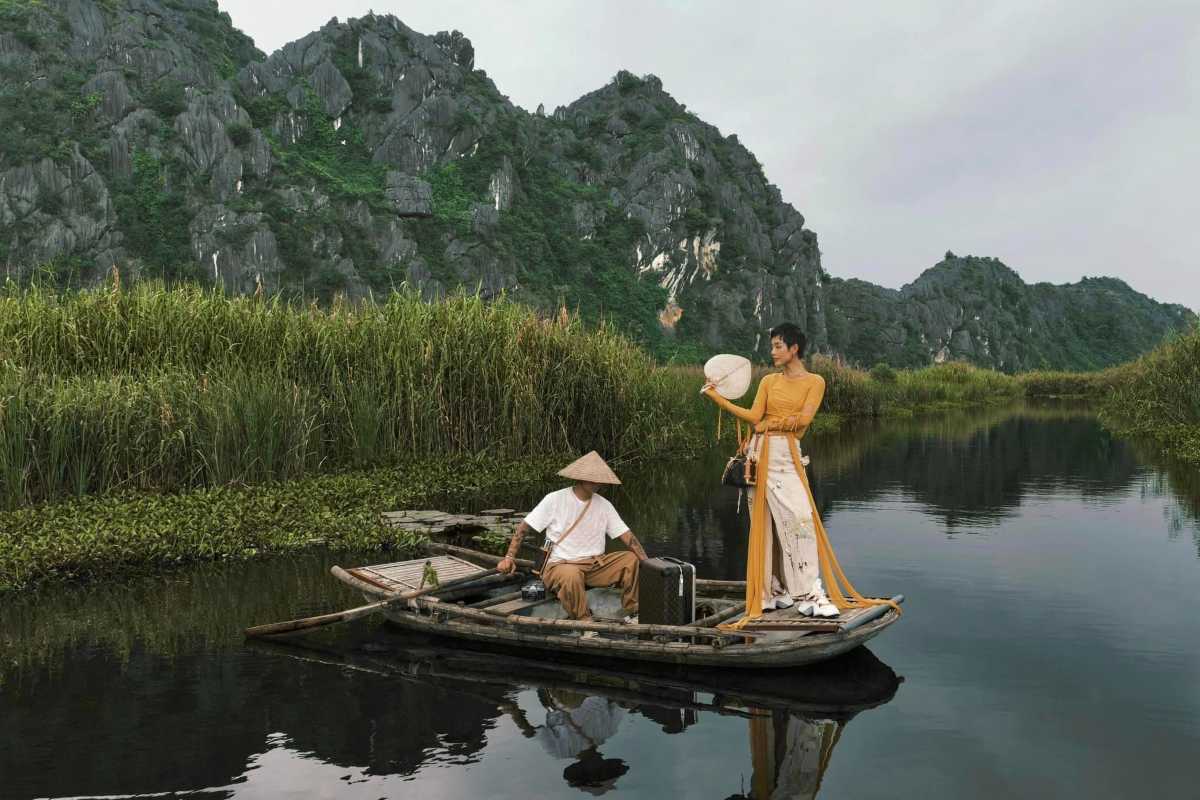
Your Travel Options to Reach Van Long
If you're planning a visit and wondering about private car hire to Van Long Nature Reserve, you're not short on choices. From independent road-trippers to eco-tour joiners, travelers can select from a range of transport modes tailored to time, budget, and comfort. Whether you want to enjoy a self-guided ride or book a full-day tour Van Long from Hanoi, here's a breakdown of your best options.
Explore your ideal way to arrive—conveniently, affordably, or with expert guidance.
Private car or motorbike from Ninh Binh or Hanoi
Private vehicles offer the most flexibility and comfort, particularly if you're traveling with family or want to make multiple stops.
- Convenience: Depart when you want and travel at your own pace.
- Cost: VND 800,000–1,500,000 for a round trip private car from Hanoi (includes driver).
- Motorbike Rentals: Available from Ninh Binh City (~VND 150,000/day), ideal for scenic backroads.
- Travel Time: ~2 hours from Hanoi by car; ~40 minutes from Ninh Binh by bike.
- Tips: Bring your international driver’s permit for legal compliance; roads are paved but can be slippery in the wet season.
Private transport gives you the freedom to explore Van Long’s peaceful charm on your own schedule.
Think convenience is worth the cost? A private ride might be your perfect fit.
Public transport via train or bus, then local taxi
For budget-conscious travelers, public transport to Van Long Ninh Binh is a straightforward option that doesn’t compromise on experience.
- Train: Take a Reunification Express from Hanoi to Ninh Binh Station (~2 hours).
- Bus: Limousine buses from My Dinh or Giap Bat stations offer comfort and speed (~1.5–2 hours).
- Final Leg: From Ninh Binh, hire a local taxi or Grab (~VND 150,000–200,000) to Van Long.
- Pros: Low cost, regular departures, ideal for flexible itineraries.
- Considerations: Less control over timing, potential language barriers when hailing taxis.
Prefer savings and spontaneity? Public transport offers an affordable way to see Van Long with minimal fuss.
Booking a full-day tour package from Hanoi
Joining a full-day tour Van Long from Hanoi is ideal for those who prefer an organized, worry-free experience.
- Inclusions: Air-conditioned transport, local guide, entry fees, and a Van Long boat tour cost (~VND 100,000/person) often bundled in.
- Added Value: Cultural context, insider tips, and scenic photo stops.
- Booking: Available through many providers or online platforms. Asia Travel Links offers highly rated eco-tours with flexible options.
- Pricing: VND 900,000–1,400,000 depending on group size and add-ons.
- Best For: First-timers, families, or those short on time.
Want everything handled for you? A day tour makes discovering Van Long smooth and memorable.
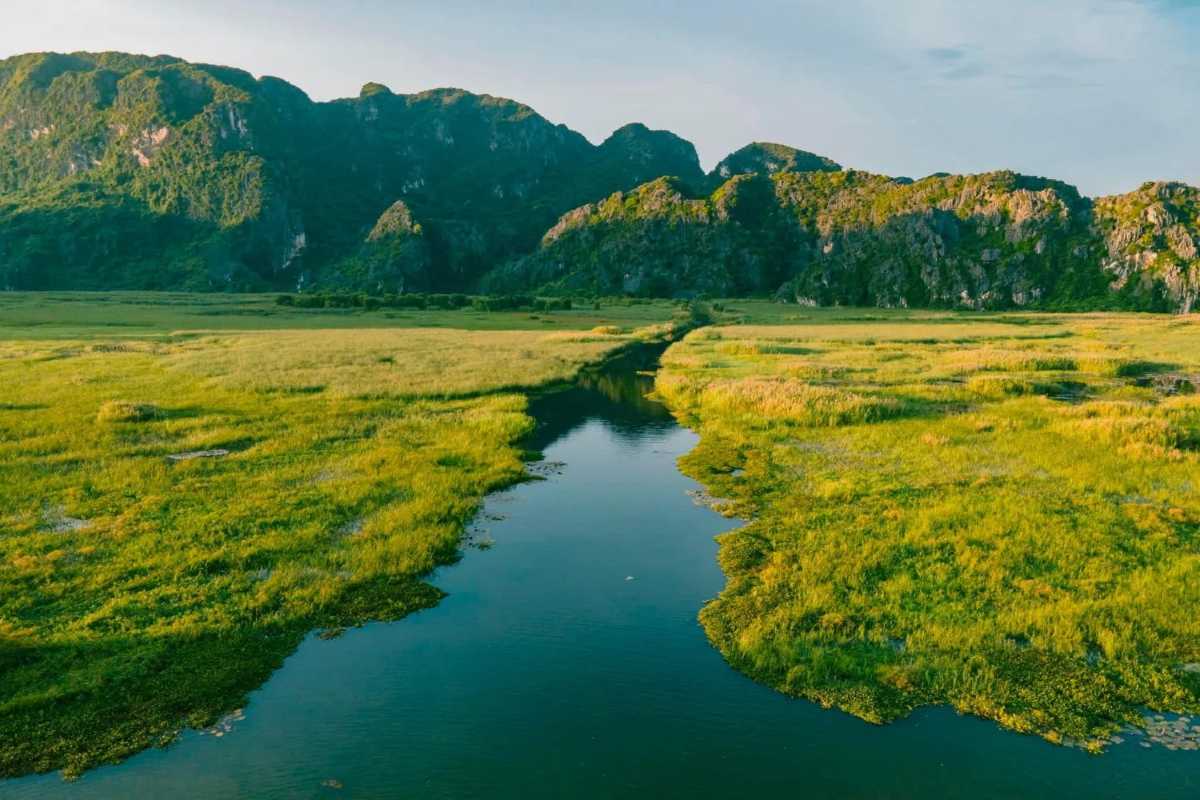
Local Access Points and Landmarks
Your journey begins at the Van Long Boat Wharf, the main gateway to explore the wetland reserve. This tranquil launch point serves as both a physical access hub and the symbolic threshold between the daily bustle and the serene world of Van Long. Whether you're arriving by taxi, train, or private car, a smooth transition into nature awaits.
Read on to locate your landmarks and navigate your way to a seamless start.
Van Long Boat Wharf (Bến thuyền Vân Long)
The Van Long Boat Wharf is the official entry point to the reserve and where your scenic journey truly begins.
- Ticketing Office: Located directly at the wharf entrance; staffed daily from 7:00 AM to 5:00 PM.
- Ticket Prices: Boat rental ~VND 100,000 for two people; entry fee ~VND 20,000 per person.
- Boats: Hand-rowed sampans operated by local villagers, offering a silent, engine-free ride.
- Waiting Area: Shaded benches, snacks, and restrooms available near the ticket booth.
- First Impressions: Limestone silhouettes and lotus-lined canals set a calm, picturesque tone.
Arrive early to beat the crowds and soak in the peaceful ambiance at the boat wharf.
Ninh Binh Railway Station and surrounding roads
Travelers arriving by train will find Ninh Binh Railway Station to Van Long a manageable trip with several route options.
- Distance: Roughly 18 km northwest of the station.
- Travel Time: 30–40 minutes by taxi or motorbike.
- Taxi Cost: Around VND 150,000–200,000 depending on time of day and provider.
- Route: Follow QL1A north, then connect to provincial roads toward Gia Van Commune.
- Tip: Have your destination written in Vietnamese (e.g., “Bến thuyền Vân Long, xã Gia Vân”) for easy communication.
From the station to the sampan, it’s a smooth journey into Vietnam’s lush inland sanctuary.
Signage and direction tips for self-guided travelers
Navigating independently? Finding the Van Long Boat Wharf on your own is refreshingly simple with a bit of preparation.
- Google Maps: Use “Van Long Nature Reserve” or “Bến thuyền Vân Long” as the input for exact pin drop.
- Road Signs: Brown heritage signs appear near Gia Van; look for icons showing boats and birds.
- Offline Tips: Download map areas ahead of time—cell reception can be patchy in some spots.
- Local Help: Don’t hesitate to ask locals—most know “Van Long” and will kindly point you in the right direction.
- Sign Language: Pointing at boat pictures works surprisingly well if language fails.
With these simple cues, even a first-timer can navigate confidently and focus on the beauty ahead.
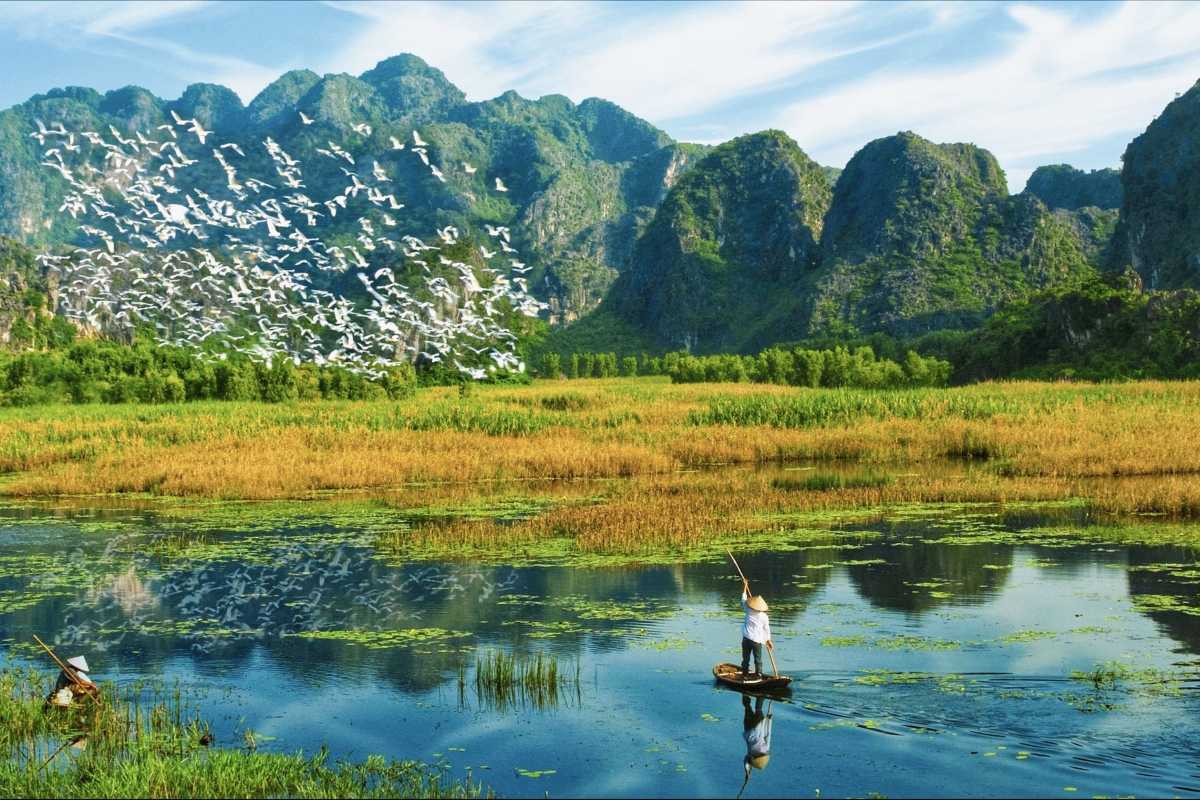
Planning Your Van Long Adventure: Pre-Trip Essentials
Before you set off to explore Van Long Nature Reserve Ninh Binh, it’s essential to plan with care. Knowing what to expect, what to bring, and how much to budget will help you travel with confidence and comfort. From ticket prices to local food costs, having your essentials sorted lets you focus on the tranquil beauty that awaits.
Let’s dive into how you can make the most of your visit with practical preparation.
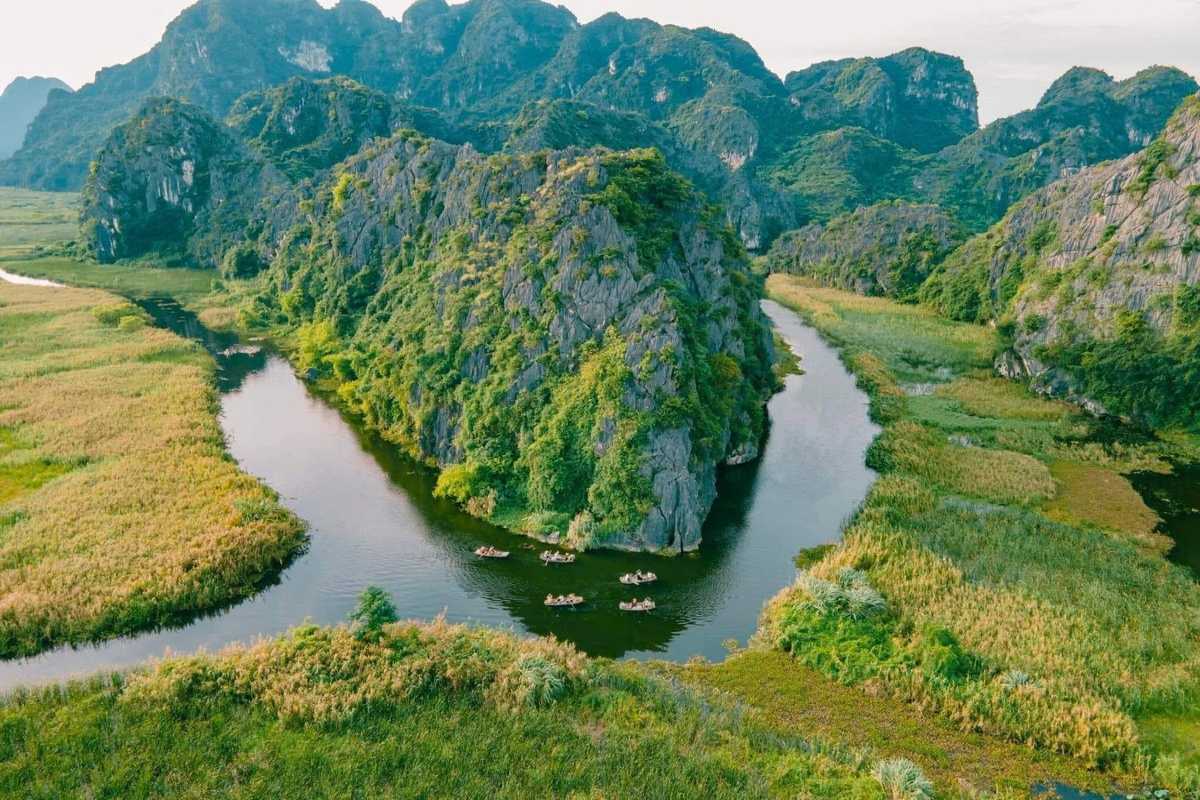
Budgeting for Your Van Long Trip
The estimated cost Van Long trip can vary depending on your travel style, group size, and choice of transport, but it remains one of the most affordable nature escapes in northern Vietnam. With thoughtful Van Long budgeting, you can enjoy a rich experience without overspending.
Here’s what you can expect financially and how to make the most of it.
Estimated Costs: Entrance, Boats, Transport, Food
Knowing your costs ahead of time is key to planning a smooth visit.
- Entrance Fee: VND 20,000 per person
- Boat Ride (2 people per boat): VND 100,000 total for a 1.5-hour journey
- Private Transport (from Ninh Binh): VND 150,000–200,000 per taxi or motorbike rental
- Public Bus or Train (from Hanoi): VND 100,000–150,000 one-way
- Full-Day Tour Package: VND 800,000–1,200,000 including guide, meals, and transport
- Meals in the Area: VND 50,000–100,000 per person at local eateries
Expect to spend between VND 300,000 and 1,000,000 depending on how independently or conveniently you travel.
Tips for Saving Money Without Sacrificing Experience
These smart Van Long budget tips can help stretch your funds while keeping the quality of your experience intact.
- Go with a Group: Share boat and taxi costs to reduce per-person expenses
- Bring Snacks and Water: Save on food by packing basics for your ride or wait time
- Travel Midweek: Avoid weekend price surges in transport and accommodation
- Use Public Transport: Buses and trains from Hanoi are both affordable and scenic
- Skip Guided Tours if Confident: Self-guided trips cost less and offer flexibility
A little planning goes a long way—especially when your reward is a peaceful escape into nature’s heart.
Mai's Money-Saving Hacks: Van Long on a Budget
When I planned my trip to Ninh Binh, everyone talked about the beauty, but my inner budget traveler immediately started wondering: could I experience Van Long's magic without breaking the bank? Turns out, absolutely! I managed to have an incredible, authentic day by leaning into local options and a bit of smart planning, proving you don't need a lavish tour to connect with nature here.
My first hack was transport. Instead of a costly private car from Hanoi, I took the overnight train to Ninh Binh. Waking up to the misty rice paddies outside my window felt like part of the adventure, and it saved a significant chunk of change. Once in Ninh Binh, I haggled a fair price for a motorbike taxi to Van Long. My driver, a friendly local named Binh, not only gave me a good deal but also pointed out interesting landmarks along the way, turning a simple commute into a mini-tour.
Next, food! I bypassed the few touristy restaurants near the wharf. Instead, I spotted a small, humble eatery tucked away just down the road from the boat station, filled with locals. For a fraction of the cost, I devoured a delicious, steaming bowl of bún chả and a strong Vietnamese coffee. It was fresh, authentic, and easily the best meal I had all day. I also packed my own water bottle and a few snacks, which saved me from impulse buys at the more expensive kiosks.
Finally, accommodation: I chose a homestay in a nearby village called Gia Van, rather than a guesthouse in busier Tam Coc. Not only was it significantly cheaper, but my host family cooked incredible home-style meals (included in the price!) and gave me insider tips on the best times to visit the reserve to avoid crowds. The quiet evenings, listening to the sounds of the countryside, were priceless and far exceeded any hotel experience. My Van Long trip wasn't just budget-friendly; it was richer because of these choices.
Recommendation: Don't let budget concerns deter you from Van Long! Embrace public transport, seek out local eateries, and consider a homestay for an authentic and affordable experience that truly immerses you in the local culture while safeguarding your wallet. It's proof that sometimes, the most budget-friendly option is also the most rewarding.
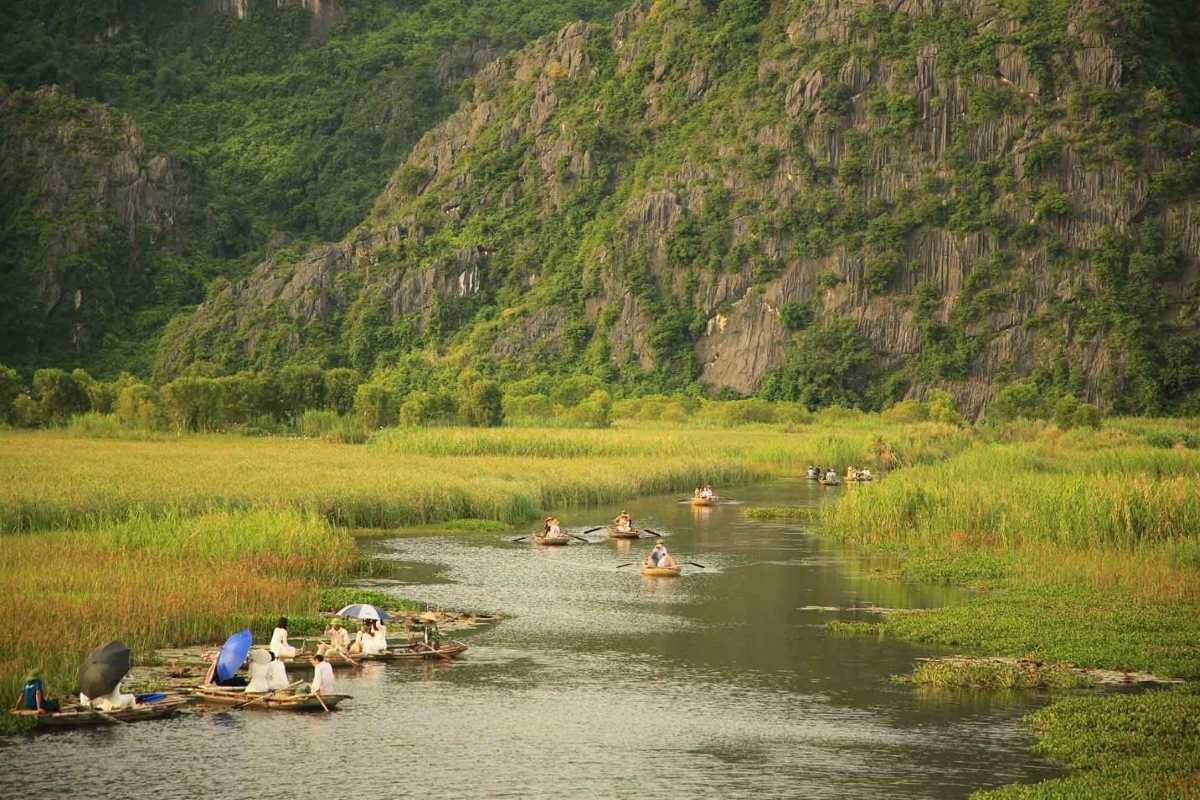
Essential Packing List & What Not to Forget
When preparing for your visit to Van Long Nature Reserve Ninh Binh, smart packing can make all the difference. From weather changes to unpaved trails, having the right gear ensures you stay comfortable, safe, and fully immersed. This Van Long packing list covers the essentials to help you enjoy a seamless and satisfying day in nature.
What to Wear for Comfort and Protection
Dressing right is the first step to enjoying the wetlands without worry. Here's what to bring to stay protected and relaxed all day:
- Lightweight Long-Sleeve Shirt: Shields against sun and mosquitoes while keeping you cool
- Breathable Pants or Leggings: Ideal for movement in boats or walking trails
- Wide-Brim Hat or Cap: Essential for sun protection during midday boat rides
- Comfortable Walking Shoes or Sandals: Choose sturdy, water-resistant footwear
- Packable Rain Jacket or Poncho: Quick coverage during sudden drizzles or humid spells
Dressing practically keeps you focused on the beauty around you—not on what you're wearing.
Photography Gear Recommendations
For photography enthusiasts, Van Long’s mirror-still waters and dramatic limestone outcrops offer a natural studio like no other. Pack the right Van Long photography gear to capture it all:
- DSLR or Mirrorless Camera: For high-resolution landscapes and wildlife shots
- Telephoto Lens (200mm–600mm): Crucial for birdwatching and langur spotting
- Polarizing Filter: Enhances water reflections and sky contrast
- Dry Bag or Waterproof Case: Protects equipment during boat rides
- Tripod or Monopod: Helps stabilize long exposures, especially in low light
With thoughtful gear choices, you’ll bring home images that do more than document—they transport.
David's Gear Review: Capturing Van Long's Serenity
As an avid amateur photographer, my trips are often planned around capturing the essence of a place, and Van Long was no exception. Before heading out, I poured over forums and articles, trying to nail down the "perfect" gear for its unique blend of towering karsts, serene waters, and elusive wildlife. What I discovered on the ground, through trial and error (and a bit of unexpected dampness!), gave me some truly solid insights into what truly works here.
My trusty mirrorless camera (a Sony A7III, if you're curious) was my main companion. For the sweeping landscapes, I initially thought my 16-35mm wide-angle lens would be glued to the camera. It was fantastic for capturing the sheer scale of the limestone mountains reflecting on the water – those grand, expansive shots that make you feel tiny. However, the real game-changer, and something I almost left behind, was my 70-200mm telephoto lens. Why? The Delacour's langurs. These incredible primates are shy and often high up on the cliffs. My wide-angle lens would have made them mere dots; the telephoto allowed me to capture their expressions and unique markings, giving me photos I truly cherish. Without it, I would have missed out on the 'wildlife' part of the nature reserve.
The unexpected twist came with the boat itself. While the bamboo boats are incredibly peaceful, they are, naturally, very low to the water. This meant a constant spray, even on a calm day. My "water-resistant" camera bag quickly proved insufficient. A small, roll-top waterproof dry bag (the kind kayakers use) became my best friend. I kept my extra lens, batteries, and phone safely tucked away inside it. This was a critical lesson learned: waterproof means waterproof, not just "a bit splash-proof." Another tip for the boat: stability is key. While a tripod is impractical, bracing my elbows against my knees or the side of the boat (carefully!) helped immensely, especially when trying to hold still for those wildlife shots.
Actionable Practical Takeaways from My Gear Experience:
- Lens Priority: If you have to choose, a telephoto lens (200mm+) is more crucial than an ultra-wide for capturing the unique wildlife, especially the Delacour's langurs. A wide-angle (16-35mm or similar) is excellent for landscapes, but the telephoto enables a different kind of photographic story.
- True Waterproofing: Invest in a dedicated waterproof dry bag for your camera gear and electronics. A "water-resistant" backpack might not cut it on the boat, especially if you encounter any unexpected splashes.
- Extra Batteries: The cool, damp air and constant use (especially if you're reviewing photos) can drain batteries faster than you expect. Bring at least two spare fully charged batteries.
- Binoculars: While not camera gear, a good pair of compact binoculars significantly enhances the wildlife spotting experience, allowing you to see details the naked eye misses before you even attempt a photo.
- Cleaning Cloths: The humidity and potential splashes mean your lenses will need frequent wiping. Pack a couple of microfiber cleaning cloths dedicated to your optics.
For any photographer, Van Long offers incredible opportunities, but coming prepared makes all the difference. My gear choices (and a few on-the-fly adaptations!) allowed me to truly capture the serene beauty and unexpected wildlife encounters that make Van Long such a special place. It's a photographer's paradise, provided you have the right tools and a little bit of foresight.
Recommendation: Don't skimp on your photography gear for Van Long, but prioritize wisely! A versatile telephoto lens and a truly waterproof bag are your non-negotiables. With these in hand, you'll be well-equipped to immortalize the reserve's unique charm and its elusive inhabitants.

Cultural Etiquette & Local Customs
Respecting the people and traditions surrounding Van Long Nature Reserve isn’t just polite—it deepens your experience and fosters mutual appreciation. Following these basic principles of Van Long cultural etiquette helps ensure your visit supports the community and leaves a positive impression.
- Greet with a Smile and a Nod: Most locals are shy but kind. A warm smile goes a long way.
- Dress Modestly: Even in hot weather, avoid revealing clothing out of respect for rural sensibilities.
- Don’t Point at People or Sacred Objects: Use your whole hand if giving directions or gesturing.
- Ask Before Photographing Locals: Especially farmers, boat rowers, or children—gain their consent first.
- Support Local Crafts and Vendors Respectfully: If browsing handwoven goods or snacks, interact kindly even if you don’t buy.
Embracing these customs opens the door to authentic interactions and shows that you're more than a tourist—you’re a respectful guest.
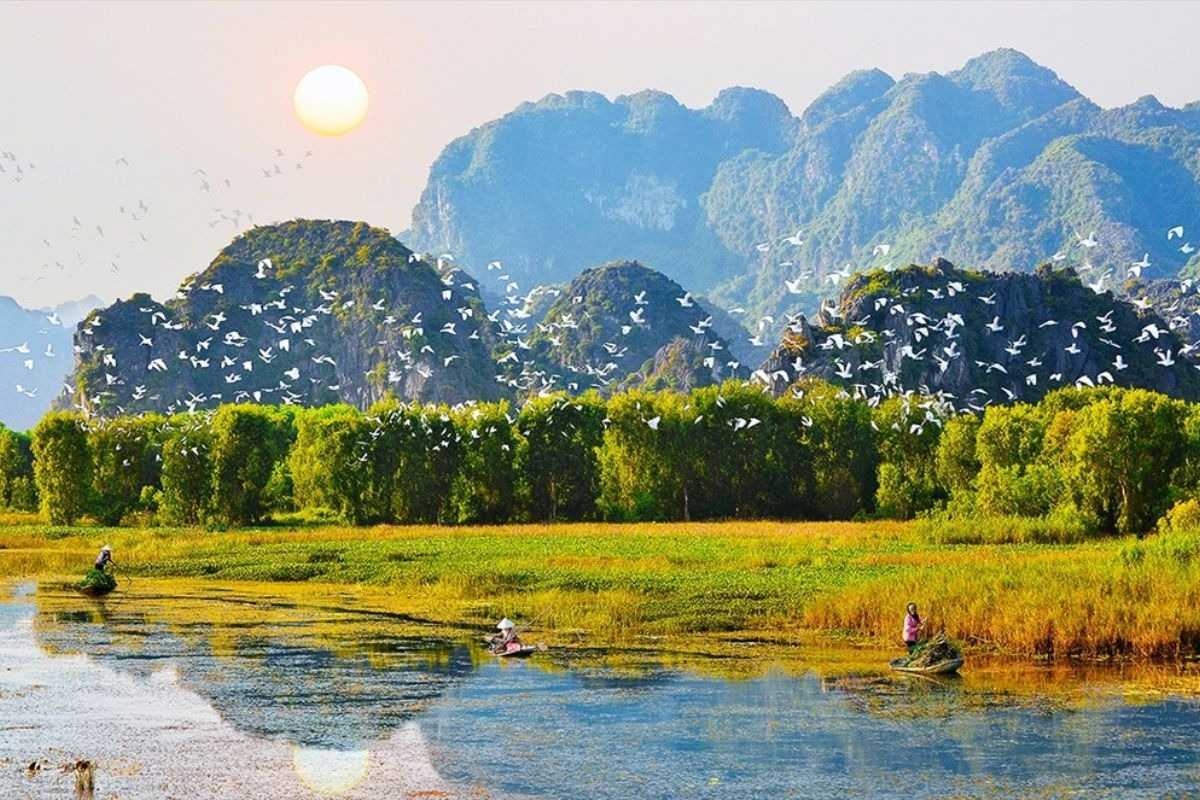
Things to Do in and Around Van Long Nature Reserve
Woven into the calm rhythm of the land, Van Long boat ride experiences and eco-friendly excursions reveal the gentle magic of rural Ninh Binh. Whether you're drawn to serene landscapes, rare wildlife, or cultural touchpoints, the reserve offers meaningful ways to explore, slow down, and reconnect with nature.
From drifting across lotus-covered waters to discovering hidden karst caves and observing endangered langurs in their natural habitat, each activity here is crafted by the natural pace of the land—not tourist clocks. It’s a place where moments matter more than itineraries.
If you're ready to feel Vietnam through silence, water, and earth, you’re in the right place.
Explore the options below and start shaping your personal journey through this Vietnam eco-tourism haven.
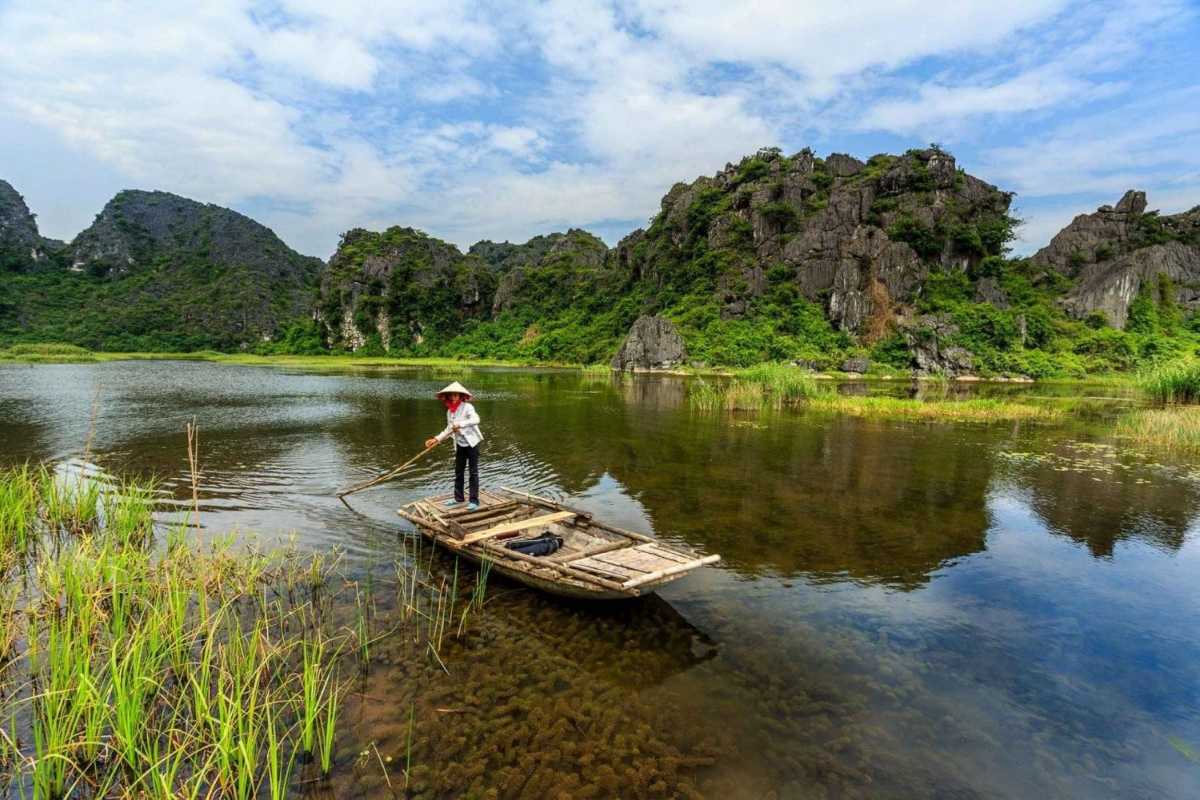
Take a Peaceful Bamboo Boat Ride Through Nature
The soul of Van Long boat ride experiences lies in their slow, meditative rhythm. Each journey is guided by a local rower—many of whom are lifelong residents of the area—who navigates narrow channels and mirror-like pools using a traditional bamboo paddle technique. It’s not just a tour; it’s a communion with the land.
These rides offer up-close views of rippling limestone cliffs, aquatic flora, and—if you're lucky—a glimpse of the elusive Delacour’s langur clambering on the karst faces. This activity is at the heart of any Ninh Binh wetland trip, setting the tone for a deeper connection with Vietnam’s untouched countryside.
For those seeking slow travel and authentic contact with rural beauty, this tranquil glide through nature is an essential experience.
Duration, route highlights, and cave passages
A typical bamboo boat Van Long duration runs from 60 to 90 minutes depending on water levels and the pace you choose. Along the way, expect to:
- Glide through shimmering channels framed by reeds and lotus blooms: A photographer’s dream.
- Enter Hang Ca and other karst caves: These water-carved tunnels add mystery and cool contrast.
- Pass by towering limestone formations: Some stretch nearly 200 meters into the sky.
- Float silently across reflection pools: Where limestone cliffs are mirrored so perfectly it’s disorienting.
You’ll leave with a camera full of shots—but it’s the stillness that stays with you longest.
To make the most of the ride, come prepared with curiosity and a willingness to unplug.
Best times of day to ride (wildlife and light)
The best time for Van Long boat ride magic is early morning or late afternoon. These golden-hour windows offer ideal conditions:
- Dawn (6:00–8:00 AM): Soft light, cool air, and the highest chance of spotting Delacour’s langurs.
- Late afternoon (4:00–5:30 PM): Sunset reflection views and flocks of birds returning to roost.
- Avoid mid-day heat (11:00–2:00): The sun can be intense and wildlife less active.
Whether you're an early riser or a sunset chaser, timing your ride enhances the mood and photo potential.

Go Birdwatching or Spot Delacour’s Langurs
Beyond the peaceful paddles and reflective waters, Van Long birdwatching unveils an entirely different layer of the reserve’s magic. With its untouched habitat and quiet environment, the wetland becomes a natural amphitheater for observing some of Vietnam’s rarest species—including the critically endangered Delacour’s langur.
These wildlife encounters aren’t guaranteed, but the thrill of the wait—binoculars raised, camera ready, heart beating in sync with rustling reeds—makes each sighting feel like a personal triumph. Whether you're hoping to spot migratory birds mid-flight or catch a langur bounding across a cliffside, knowing where to spot langurs Van Long and when to come makes all the difference.
Read on for guidance to make your encounter as rewarding as possible.
Where and when to spot langurs and rare birds
Sightings rely on timing, patience, and quiet observation. Here’s how to improve your chances:
- Morning hours (6:00–9:00 AM): Ideal for bird movement and langur activity before the heat.
- Afternoon return (4:00–5:30 PM): Some species, including herons and storks, begin their return roost.
- Cliff bases near Hang Ca Cave: Known Delacour’s langur habitat—watch for black-and-white figures on the limestone walls.
- Marsh edges and reed beds: Home to kingfishers, egrets, and other wetland birds.
- Boat silence matters: Ask your rower to avoid splashing—many are trained to guide birdwatchers.
Every trip holds the potential for that one unforgettable sighting, framed by the stillness of this hidden ecological jewel.
Equipment and tips for photographers
Whether you're a hobbyist or semi-pro, success in bird photography Van Long depends on the right tools and some field-tested wisdom:
- Mid-range telephoto lens (200–400mm): Ideal for langurs and distant birds without carrying too much weight.
- Tripod or monopod with rubber feet: Stabilizes in boats or on soft wetland ground.
- Fast shutter speed (1/1000s or higher): Captures birds mid-flight or langurs on the move.
- Muted clothing and soundless mode: Blend into the setting and avoid disturbing wildlife.
- Weatherproofing and dry bags: Keep gear safe in mist, rain, or boat spray.
Bring patience, too. The best frames often come when you least expect them—so stay present, quiet, and observant.

Explore Van Long Caves and Limestone Cliffs
For many visitors, the call of discovery isn’t just on the water—it echoes from the towering cliffs and secret passages carved into stone. To explore Van Long caves is to step into a realm where geology meets legend, and every echo inside a cavern seems to whisper of ancient secrets.
Tucked within the reserve’s karst formations lie several grottoes and chambers, some reachable by boat, others along walking paths or beneath overhangs. Names carry weight here—some literal, like Fish Cave, Bong Cave, Turtle Cave Van Long, and others steeped in local tale, like Meo Cao, where folklore shapes your sense of place as much as the rock beneath your feet.
These quiet corners often escape guidebooks, but they hold stories and serenity all their own. Here's what to know before you go.
Notable caves: Fish Cave, Bong Cave, Turtle Cave
Each cave offers a glimpse into Van Long’s geological past and cultural identity:
- Fish Cave (Hang Ca): The most accessible and well-known, often part of the boat tour route. Inside, you might glimpse schools of native fish gliding through crystal-clear pools.
- Bong Cave: A smaller, less-visited grotto nestled between cliff folds—ideal for quiet moments and photography.
- Turtle Cave (Hang Rua): Known for turtle sightings and cool, shaded air. Entry depends on water levels and should be confirmed locally.
- Note on safety: Always wear grip shoes when exploring on foot. Some caves are slippery or dark—bring a small flashlight and follow any local guidance.
A visit to these natural formations adds a layer of depth beyond surface beauty, revealing Van Long’s quiet grandeur one rock face at a time.
Scenic cliffs with folklore-inspired names like Meo Cao
The cliffs in Van Long aren’t just geological marvels—they're storytellers, too. Locals will point to jagged peaks and softly murmur legends linked to their shapes, shadows, and silence.
- Meo Cao Cliff (Mèo Cào): Said to resemble a crouching cat in defensive posture. According to Meo Cao folklore Van Long, a protective spirit cat once guarded the wetlands from storms.
- Nghiêm Cliff: Often compared to a praying monk—a peaceful guardian watching over the lagoon.
- Coc Mountain: Popular for panoramic views and traditional herbal foraging.
- Locals as guides: Many boatwomen grew up among these stories. Don’t hesitate to ask them for the tales—many will gladly share as they paddle.
By walking the cliffs and hearing their whispered myths, you step deeper into the reserve—not just as a visitor, but as a part of its living story.

Van Long Cycling Tours Through Peaceful Village Paths
Few experiences capture the charm of rural Vietnam like a slow ride past golden paddies, grazing water buffalo, and tiled-roof homes nestled among limestone backdrops. Van Long cycling tours offer just that—a way to step off the tourist trail and into the quiet rhythms of local life.
Whether you're renting a bike for a self-guided Van Long cycling adventure or joining a local-led tour, the region offers an intimate look at the everyday beauty surrounding the reserve. It’s not about speed—it’s about soaking in every moment.
Popular cycling paths along dikes and rice paddies
Van Long’s flat terrain and narrow roads make it perfect for casual cyclists of all ages. The most scenic routes include:
- Dike paths around the wetland edge, offering sunrise or sunset views over still water and towering cliffs.
- Village loops through Gia Van and Gia Hoa, where children wave and farmers smile from shaded porches.
- Rice field trails that change with the seasons—from vibrant green growth to golden harvests or reflective floodwater.
- Pagoda detours, such as visiting Nguyen Temple or smaller shrines along the way.
These routes are not only photogenic but deeply immersive, connecting you with the land’s seasonal pulse and the people who call it home.
Self-guided vs. local-led rural cycling tours
Depending on your comfort level and travel style, both self-guided and guided options are rewarding:
- Self-guided Van Long cycling
- Pros: Full flexibility, freedom to stop wherever you like, lower cost
- Cons: Requires basic navigation and some language preparation
- Ideal for: Independent travelers who enjoy getting a little lost on purpose
- Local-led tours
- Pros: Cultural insights, language help, visits to hidden spots
- Cons: Slightly higher cost, set route and timing
- Ideal for: Families, couples, or first-time rural cyclists
Bike rentals are available at homestays or near the Van Long Boat Wharf for a small fee. Helmets and maps may not be standard—ask in advance or bring your own.
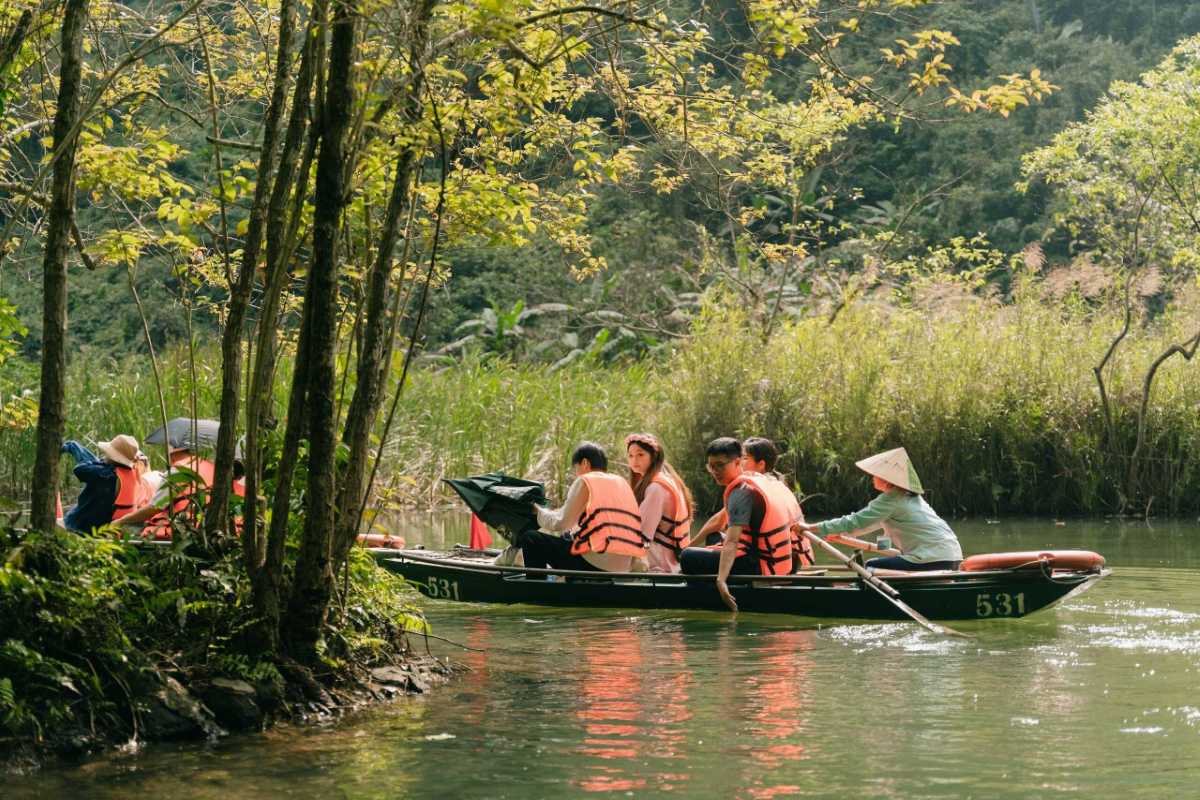
Van Long Cultural Sites for a Deeper Connection
Beyond its serene wetlands and dramatic cliffs, Van Long Nature Reserve Ninh Binh offers access to lesser-known yet culturally rich destinations that add depth to your visit. Exploring Van Long cultural sites allows you to connect with the spiritual traditions and historic rhythms that shape life in this quiet part of northern Vietnam.
Ancient temples, rustic churches, and traditional festivals provide meaningful touchpoints for travelers who want more than just a scenic landscape. These sites are peaceful, uncrowded, and grounded in centuries of rural heritage.
Thung La Temple and Lang Van Church
Nestled between rice fields and karst peaks, Thung La Temple Van Long is a modest yet spiritually significant site where villagers pay homage to ancestral deities and local spirits. The temple’s simple wooden structure and quiet courtyard exude a timeless charm that invites slow reflection.
A short bike ride away, Lang Van Church offers a contrasting yet complementary spiritual experience. Built during the French colonial period, it features classic Catholic architecture adapted to the Vietnamese countryside. Visitors often find the juxtaposition of Buddhist and Catholic traditions in such close proximity fascinating—and uniquely Vietnamese.
Both sites are easy to access by foot or bicycle from the Van Long Boat Wharf, and they rarely see heavy tourist traffic, making your visit feel especially personal.
Traditional ceremonies and festivals in the commune
To witness local culture in full bloom, consider aligning your visit with a seasonal event:
- Spring rituals (around Lunar New Year) held at Thung La Temple, where incense offerings and traditional costumes animate the site.
- Village ancestor days, typically celebrated in early autumn, bring together families for communal meals, folk games, and worship.
- Harvest festivals, often hosted in nearby communes, offer music, lion dances, and vibrant food stalls.
These occasions are windows into local life and values, and visitors are often warmly welcomed. Just remember to dress modestly and observe respectfully.
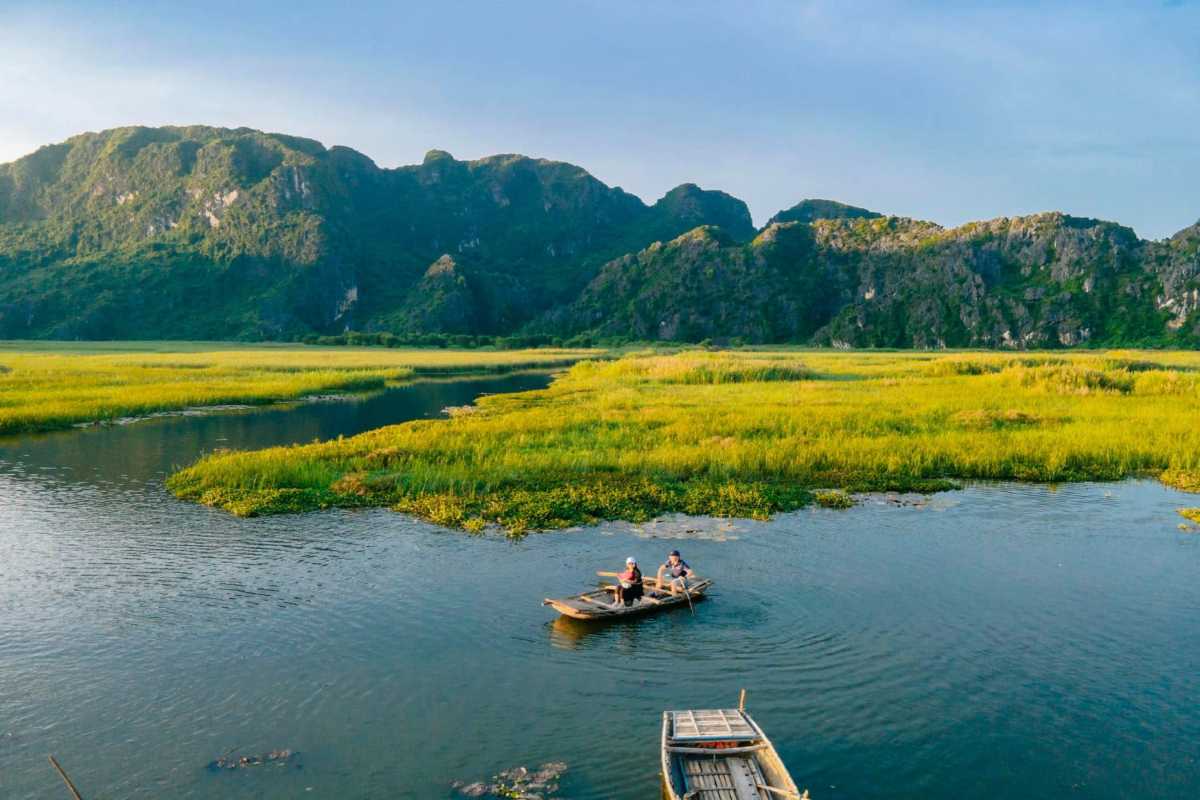
Van Long Photography Hotspots & Best Angles
Whether you're a casual Instagrammer or a seasoned shutterbug, Van Long photography hotspots offer rich rewards. With calm reflective waters, towering karsts, and rare wildlife, the reserve is a dream canvas for visual storytelling. Knowing where—and when—to shoot makes all the difference in capturing Van Long’s quiet magic.
The soft morning light and golden hour before sunset offer ideal conditions. Bring a zoom lens if you’re hoping to catch elusive wildlife or distant cave formations. Photographers often find unexpected inspiration in the small moments: a bird lifting off from lotus reeds or a boat slicing through still water.
Iconic Views from the Boat
Some of the most striking images are taken right from the traditional bamboo boat. As you glide through narrow waterways framed by limestone cliffs, watch for:
- The mirrored reflections of karsts in the water—best captured on still, windless mornings.
- Natural cave arches, especially as you enter Bong or Fish Cave.
- Framing shots, using boat paddles or passengers in the foreground for scale.
- Low-angle compositions, taken just above the waterline for immersive depth.
Sitting at the front of the boat offers the cleanest view—ask your guide if it’s okay to switch positions for a few shots.
Capturing Wildlife Moments
For those interested in bird photography Van Long, patience and silence are key. Early morning tours (6:30–8:00 a.m.) yield the best chances of spotting:
- Delacour’s langurs perched on karst ledges—use a fast shutter to freeze motion.
- Herons and storks mid-flight—track their arc above the wetlands.
- Reflections of flocks in still water—ideal for symmetrical framing.
- Dragonflies and marsh insects, perfect for macro photography near reeds.
Use continuous focus mode and high burst settings to catch movement in tricky light conditions. Don’t forget a dry bag to protect your gear.
Mark's Photo Diary: Hunting for the Perfect Langur Shot
My trip to Van Long wasn't just about enjoying the scenery; it was a personal quest to capture a truly stunning photograph of the elusive Delacour's langur. I'd seen pictures online, but the challenge of finding and photographing these critically endangered primates in their natural habitat was a thrilling prospect. It wasn't easy, but the satisfaction of finally getting "the shot" was immense.
My first morning on the boat, I was all anticipation, camera ready. We glided past incredible rock formations, and I was snapping away at the reflections and the lush greenery. Then, our rower, a quiet woman with sharp eyes, pointed to a distant cliff face. "Langur," she whispered. My heart pounded. I quickly raised my telephoto lens, but they were tiny, high up, and partially obscured by foliage. I managed a few blurry shots – more proof they were there than actual photos. It was a humbling start, a reminder that wildlife photography requires patience and a bit of luck.
The next day, I changed my strategy. Instead of hoping to stumble upon them, I asked my homestay host about the best times and areas for langur sightings. She suggested going out earlier, right at sunrise, and focusing on specific sections of the reserve where they'd been seen recently. This insider tip was invaluable. We set out just as the first light touched the karsts, and the air was still cool and crisp. We waited, patiently, near a particular cliff. The silence was profound, broken only by the chirping of insects and the gentle dip of the oar. Then, there it was – a flash of black and white, then another. A small family of langurs, moving gracefully across the rock face, foraging. This time, I was ready. I steadied my camera, adjusted my settings for the low morning light, and fired away. The light was soft, the langurs were relatively close, and for a few glorious minutes, they seemed to pose. It was a magical, unforgettable encounter, and I knew I had my shot.
Actionable Practical Takeaways from My Langur Hunt:
- Timing is Everything: For wildlife, especially shy creatures like the Delacour's langur, early morning (sunrise) or late afternoon (dusk) are often the best times. They are more active and the light is softer for photography.
- Leverage Local Knowledge: Don't hesitate to ask your boat rower or homestay host for recent sightings or preferred areas. They are invaluable sources of "insider" information.
- Patience is a Virtue: Wildlife photography is rarely a quick grab. Be prepared to wait quietly and observe. Rushing or making sudden movements will likely scare them off.
- Telephoto Lens is Non-Negotiable: As David mentioned in his review, a telephoto lens (200mm+) is absolutely essential. The langurs are often high up and far away.
- Stable Shooting Platform: While a tripod isn't practical on the boat, brace yourself against the boat's side or use a beanbag if you have one, to minimize camera shake, especially in lower light.
My experience hunting for the perfect langur shot in Van Long was more than just a photography mission; it was a lesson in patience, respect for nature, and the incredible rewards of truly immersing yourself in a destination. If you're a wildlife enthusiast or a photographer seeking a unique challenge, the Delacour's langurs of Van Long offer an unparalleled opportunity.
Recommendation: For any photographer or wildlife enthusiast visiting Van Long, make it your mission to seek out the Delacour's langurs. Arm yourself with a good telephoto lens, a lot of patience, and the willingness to wake up early, and you might just capture a truly once-in-a-lifetime image.

Beyond the Boats: Unique Ways to Experience Van Long
While the iconic bamboo boat ride remains the heart of the visit, Van Long Nature Reserve Ninh Binh offers other immersive ways to experience its wild beauty. For those seeking a deeper connection or a more active adventure, these alternatives invite you to engage with the wetland landscape from fresh angles—quietly, intimately, and often with fewer crowds.
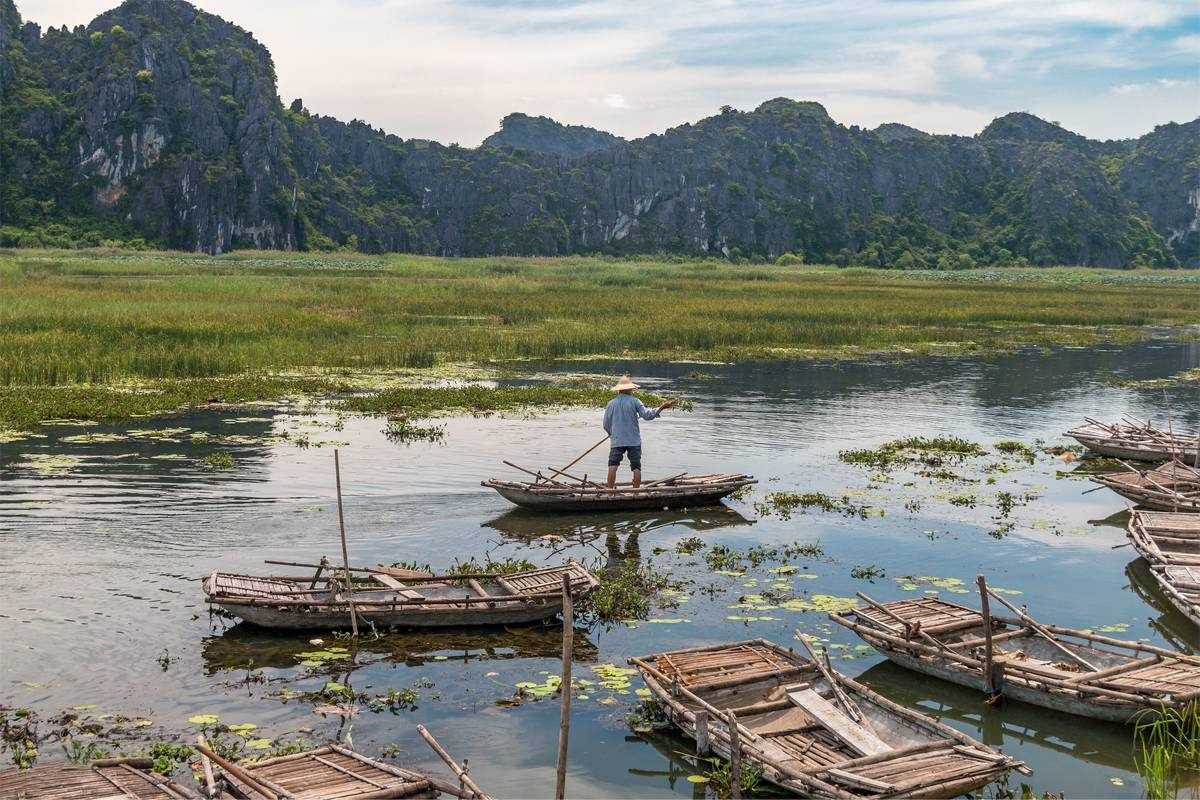
Kayaking or SUP in Designated Areas (If available/safe)
For a more hands-on experience, consider trying to kayak Van Long Nature Reserve or explore via SUP Van Long Wetland tour—if conditions permit and services are available during your visit. These low-impact, eco-friendly activities allow you to quietly glide through the waterways at your own pace, making for an entirely different interaction with the reserve.
Paddling under your own power brings you closer to the sounds and rhythms of the wetland—frog calls, bird cries, and the gentle splash of your blade breaking the surface. Unlike the bamboo boat tours, kayaking and SUP offer flexibility: pause beneath an overhanging cliff, float silently into birdwatching zones, or navigate shallower areas where boats don't go.
While these experiences may not be offered year-round or in all zones due to conservation efforts, some local operators do provide guided kayak or SUP tours under responsible tourism principles. Always check with Van Long’s visitor center or a registered eco-tourism provider beforehand.
These active options don’t just elevate the adventure—they make you part of the landscape, not just a spectator.
Liam's Paddle Adventure: A New Perspective on Van Long
I'm usually one for trying things a little differently, so when I heard whispers that, in certain permitted areas, you could experience Van Long by kayak instead of the traditional bamboo boat, my ears perked up. Most visitors choose the serene, guided boat tours, and for good reason – they're incredibly peaceful. But for me, the idea of paddling through those emerald waters, at my own pace, felt like an irresistible call to adventure, promising a deeper connection with the reserve.
From the moment I pushed off from the small, designated launch point, a new sense of freedom washed over me. Unlike the rhythmic silence of the bamboo boat, here, it was my paddle breaking the surface, my muscles propelling me forward. The initial feeling was exhilarating, almost like I was cheating, getting a more intimate look at Van Long's secrets. Being so low to the water, the reflections of the towering karsts were even more dramatic, mirroring perfectly in the glassy surface. I could glide right up to the water's edge, observing tiny fish darting through the reeds and small, iridescent dragonflies hovering inches from my face. The sounds were amplified too – the gentle lapping of water against my kayak, the distant calls of birds, and the soft rustle of leaves in the breeze.
There were challenges, of course. Navigating some of the narrower passages required a bit more skill than I anticipated, especially when a gentle current tried to nudge me into a limestone wall. And while the early morning sun was beautiful, the open kayak meant full exposure, so I was glad for my wide-brimmed hat. But these minor hurdles only added to the sense of accomplishment. The payoff was immense: pulling my kayak into a quiet cove, completely alone, with only the sounds of nature surrounding me. I managed to spot a few grey-headed lapwings wading along the banks, and even caught a glimpse of a kingfisher. Being able to stop, drift, and simply soak in the atmosphere without a schedule was incredibly liberating. It felt less like a tour and more like an expedition.
My "expertise" from this experience lies in understanding that kayaking offers a truly unparalleled sense of immersion at Van Long, for those willing to put in a little effort. It’s not for everyone – the traditional boats are fantastic for a relaxed experience – but if you crave that active, self-directed exploration and a closer connection to the water, it's a game-changer.
Actionable Practical Takeaways from My Kayak Adventure:
- Check Availability First: Kayaking/SUP is often in designated areas only and might require special arrangement or rental from specific local providers. Don't assume you can just show up with your own. Inquire locally or with your guesthouse beforehand.
- Sun Protection is Key: You'll be fully exposed to the sun. Wear a wide-brimmed hat, sunglasses, and high-SPF waterproof sunscreen. Consider a long-sleeved rash guard.
- Pack Light & Waterproof: Bring only essentials, and ensure everything – phone, camera, snacks, extra clothing – is secured in a truly waterproof dry bag. Splashes are inevitable.
- Basic Paddling Skills: While not whitewater rafting, having some basic kayaking or SUP experience will make your trip more enjoyable and less stressful, especially in narrow sections or if there's a light breeze.
- Go Early: Just like the bamboo boats, the early morning offers the calmest water, softest light for photography, and the most profound sense of solitude. Plus, it's cooler!
- Bring Water and Snacks: You'll be exerting yourself, and there are no shops once you're on the water. Stay hydrated and fueled.
Paddling through Van Long was an unforgettable experience that allowed me to truly connect with its raw, untouched beauty on my own terms. If you're an active traveler seeking a deeper, more personal engagement with this incredible nature reserve, and you're comfortable with a paddle in hand, Liam's Paddle Adventure says: go for it. It's a perspective few get to experience, and it's absolutely worth the effort.
Recommendation: For adventurous souls and active travelers, seeking out a kayaking or SUP experience in Van Long is highly recommended. It offers a unique vantage point, a profound sense of independence, and an unparalleled level of immersion that goes beyond a typical tour. It's an active way to discover the reserve's serenity.
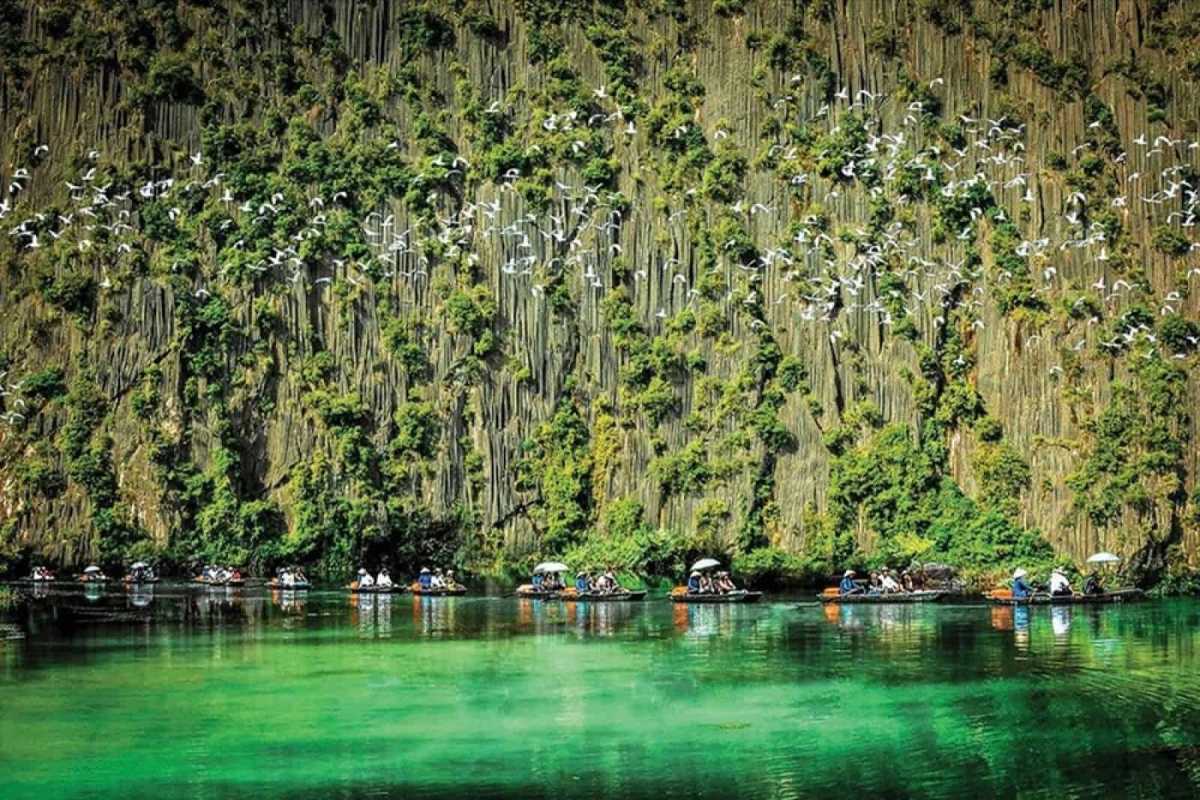
Interacting with Local Artisans & Community Initiatives
One of the most enriching aspects of visiting the region is connecting with a local artisan Van Long community. Beyond the reserve’s natural wonders, these human stories of tradition, resilience, and craftsmanship add soulful depth to your journey. Whether you stop by a weaving household, observe rice paper drying in the sun, or participate in a storytelling session, these moments leave a lasting impression and support community tourism Ninh Binh efforts.
By engaging with these locals, travelers contribute to the preservation of intangible heritage while directly supporting livelihoods built on age-old skills. These encounters are not commercialized attractions but living traditions that flourish when honored and shared respectfully.
Craft Villages and Souvenir Shopping
For those seeking to take home more than just photos, visiting nearby craft villages offers the chance to find a truly ethical souvenir Van Long Ninh Binh region. Handmade items like bamboo fish traps, embroidered textiles, or coconut-shell crafts reflect the area’s rural ingenuity and connection to the landscape.
- Gia Thinh and Gia Van villages often showcase family-run craft stalls near the reserve entrance.
- Handwoven baskets and trays made from native reeds are both functional and beautiful keepsakes.
- Rice straw paintings or lanterns crafted by local youth groups offer a creative twist on traditional materials.
- Avoid plastic trinkets sold in tourist-heavy zones and opt instead for items that reflect authentic local identity.
Choosing these souvenirs not only supports the local artisan Van Long communities, but also deepens your personal story from the trip. Each item carries the hands, history, and heritage of Ninh Binh's people.
Olivia's Artisan Encounter: Finding Local Treasures
My travel philosophy usually revolves around nature and food, but I’ve learned that the true heart of a place often lies in its local crafts and the hands that create them. After a serene morning boat ride through Van Long, I decided to wander beyond the main tourist path, hoping to find something that truly encapsulated the spirit of Ninh Binh. What I stumbled upon was a small, unassuming shop in a nearby village, and it led to an artisan encounter that was far more enriching than any souvenir I could have just picked up at a market.
The shop was barely more than an open-front room, filled with what looked like intricate, miniature landscapes crafted from dried rice stalks and other natural materials. It was a stark contrast to the mass-produced trinkets I’d seen elsewhere. A woman, probably in her late 50s with nimble fingers, sat hunched over a workbench, meticulously arranging tiny pieces of what looked like straw. Her name was Mrs. Lien, and with a warm smile and gestures (and my limited Vietnamese), she invited me closer.
She was creating a delicate diorama of the very karsts and rice paddies I had just seen from the boat, using only natural elements harvested from the surrounding area. She showed me how she dyed the rice stalks using natural pigments from local plants, how she twisted individual strands to create miniature trees, and how she used tiny fragments of eggshell for distant clouds. There was such profound patience and passion in her movements. I learned that this craft, passed down through generations in her family, wasn't just about making things; it was about preserving the landscape, transforming its raw materials into art that told a story. She explained that each piece, even the smallest, could take days to complete. Seeing the dedication, the intricate detail, and the tangible connection to Van Long itself gave the art an entirely different meaning. It wasn't just a pretty object; it was a piece of Mrs. Lien's soul, and a piece of Van Long.
Actionable Practical Takeaways from My Artisan Encounter:
- Venture Beyond the Main Hub: While the boat wharf has some shops, a short walk or cycle into the immediate surrounding villages (like Gia Van Commune) can lead you to more authentic, smaller-scale artisan workshops.
- Look for Natural Materials: In Ninh Binh, many crafts incorporate natural elements like rice stalks, bamboo, or even local stone. These are often indicators of locally sourced, traditional products.
- Engage with the Creator: If possible, try to interact with the artisan. Even with a language barrier, gestures and a genuine smile can open doors to understanding their craft and process. It transforms a purchase into a meaningful exchange.
- Quality Over Quantity: Resist the urge for cheap, mass-produced souvenirs. A single, well-crafted item bought directly from an artisan supports their livelihood and carries a much richer story.
- Be Prepared for Cash: Many small local shops or workshops may not accept credit cards. Have small denominations of Vietnamese Dong (VND) ready.
My encounter with Mrs. Lien and her beautiful rice-stalk art was a true highlight, a reminder that the real treasures of travel are often found off the beaten path, in the quiet dedication of local hands. It wasn't just about finding a souvenir; it was about discovering a story and connecting with the heart of Van Long.
Recommendation: Don't miss the chance to seek out and support the local artisans near Van Long. Look for small, independent workshops, especially those featuring crafts made from local materials. Engaging directly with the creators, like I did with Mrs. Lien, offers a deeply rewarding cultural experience and ensures you take home a truly meaningful piece of your journey.
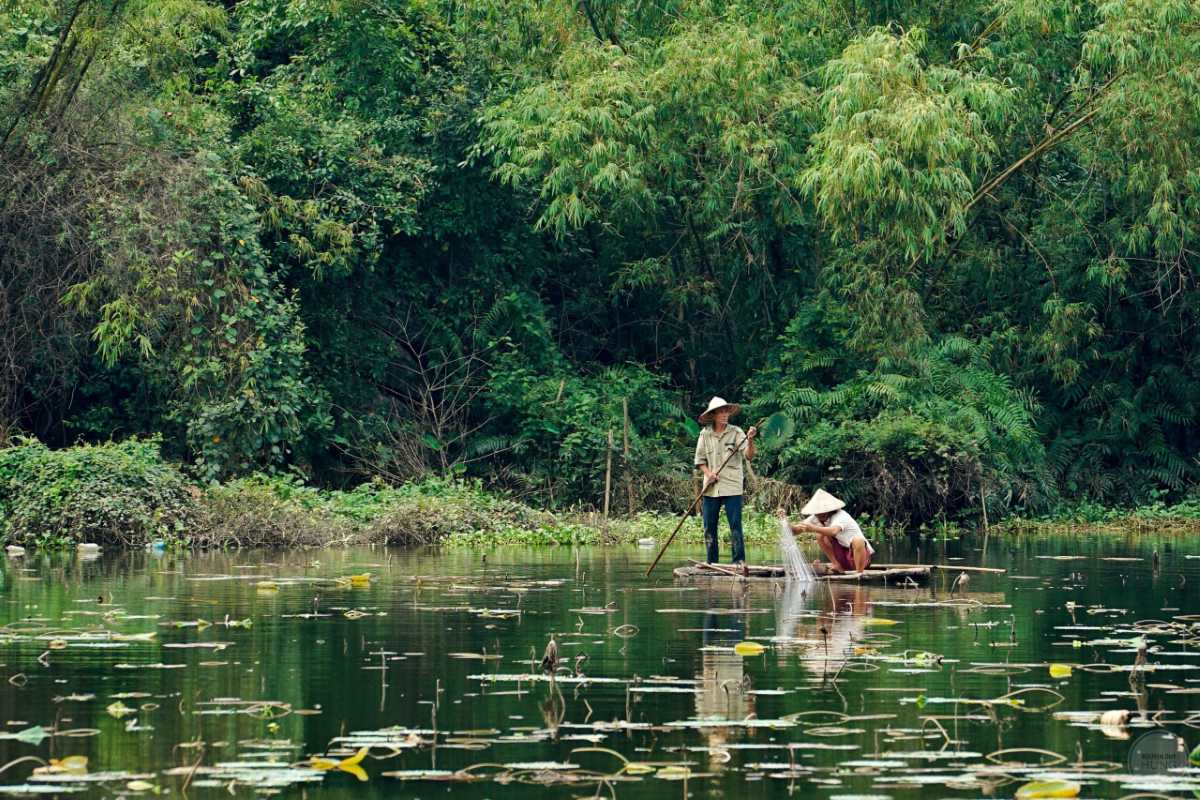
When Should You Visit Van Long Nature Reserve?
If you’re wondering about the best time to visit Van Long Nature Reserve, timing your trip around seasonal highlights can make a big difference in what you see—and how you experience it. From misty mornings filled with bird calls to lotus-covered wetlands glowing under the sun, each period brings a different kind of magic. Whether you seek rich wildlife sightings, peaceful weather, or vibrant natural scenery, Van Long offers something special year-round.
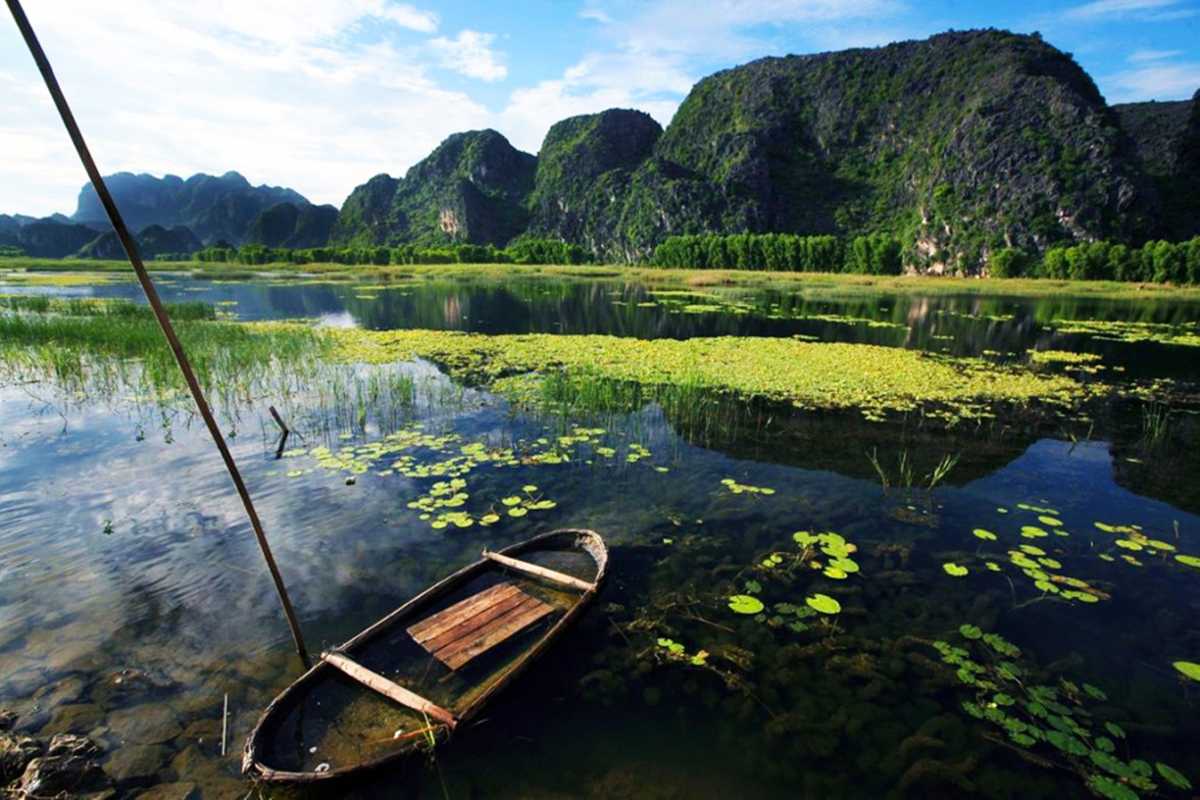
Best Times of Year to Plan Your Trip
The climate around Van Long Nature Reserve follows Vietnam’s typical northern weather patterns, offering two main visiting windows, each with distinct advantages. The dry season (November to April) is the most comfortable and popular time to explore, while the lotus bloom (May to June) offers unrivaled visual beauty, albeit with tropical heat. Here’s how to choose your perfect season:
Lotus season (May–June) for scenery and flowers
During late spring and early summer, Van Long transforms into a painter’s dream. Expansive ponds shimmer with pink lotus blossoms, creating a surreal backdrop for photos and boat rides. The air is thick with floral fragrance, and the scenery feels like a living watercolor.
- Expect higher humidity and temperatures around 30–35°C (86–95°F).
- Early mornings or late afternoons are best for cooler, more photogenic light.
- Ideal for romantic, scenic, or nature photography-focused trips.
If vivid landscapes and blooming beauty are your top priorities, lotus season may be worth the tropical warmth.
Dry season (Nov–April) for birdwatching and clear skies
For those more focused on wildlife, trekking, and comfort, the dry season offers the perfect mix:
- Cooler temperatures ranging from 18–27°C (64–81°F) make for pleasant days on the boat.
- Lower humidity and minimal rainfall ensure clearer skies and better visibility.
- Best chance for birdwatching, especially from December to March when migratory species join native birds.
- Delacour’s langurs are also more likely to be spotted basking on the karsts during sunny hours.
This season is optimal for active exploration and nature observation, especially for photographers and families seeking stable weather.

Ideal Time of Day for Each Activity
To get the most out of your visit to Van Long Nature Reserve, it’s not just about the season—it’s also about the hour. Daily rhythms of wildlife and light shape the experience. Whether you’re chasing the perfect photo, hoping to glimpse rare langurs, or seeking serenity on still waters, timing is everything.
Afternoon for best animal sightings (15:30–16:30)
The late afternoon, especially between 3:30 PM and 4:30 PM, is the prime hour for wildlife observation. As the heat subsides, animals become more active—emerging from the limestone cliffs and heading toward the wetland edges to drink or forage.
- This is the best chance to spot Delacour’s langurs sunning themselves or climbing the karst formations.
- Birds like herons and storks often swoop in to feed, making it an excellent hour for casual wildlife watching or serious photography.
- The warm, directional sunlight also enhances the drama of your landscape shots.
For visitors keen on wildlife viewing, this is the golden window to time your boat tour.
Morning for peaceful paddling and fewer crowds
Set off just after sunrise, and you’ll encounter Van Long at its most tranquil. The water mirrors the cliffs in perfect stillness. The soft light from 6:00 AM to 8:00 AM bathes the wetlands in misty hues, perfect for peaceful paddling or serene landscape photography.
- Fewer tour groups mean less noise and more solitude.
- It’s an ideal time for quiet reflection, nature immersion, or birdwatching without distractions.
- Morning air is cooler and more comfortable—great for those sensitive to heat.
If you value calm, beauty, and unhurried exploration, start your day early at Van Long Nature Reserve.

Avoiding the Crowds and Making the Most of It
Van Long Nature Reserve Ninh Binh is known for its serenity—but timing your visit right ensures you experience it at its most peaceful. To fully enjoy the wetlands, especially for photography or quiet reflection, planning around peak periods is key.
Weekdays vs weekends and low season tips
Visiting Van Long on weekdays is highly recommended if you want to avoid crowds and fully enjoy the silence of the wetlands. Weekends and Vietnamese public holidays tend to bring in local travelers and group tours.
- Choose weekdays, especially Tuesday through Thursday, for minimal traffic at the boat wharf.
- Visit during the low season (late May to early October) to experience Van Long at its quietest—just be mindful of occasional summer rains.
- If you must go during peak season (e.g., dry season weekends), arrive by 6:00 AM or after 4:30 PM to beat the rush.
- Tour buses typically arrive mid-morning and depart mid-afternoon, so timing your trip around this avoids the heaviest footfall.
These small adjustments will dramatically improve your experience and help preserve the peaceful charm that makes Van Long so unique.
Best time for photographers and solo travelers
For photographers and solo travelers, early mornings are ideal. From 6:00 AM to 8:00 AM, the wetlands are at their quietest and most photogenic. You’ll catch golden light on the cliffs, mirror-like water surfaces, and minimal human activity. Solo visitors will appreciate the calm surroundings, perfect for immersive nature moments or self-guided exploration.

Taste of Ninh Binh: Dining Experiences Near Van Long
Exploring Van Long Nature Reserve Ninh Binh isn’t just a feast for the eyes—it’s also a gateway to some of the most flavorful dishes in Northern Vietnam. After a tranquil boat ride or a morning of wildlife spotting, treat yourself to a culinary adventure that reflects the soul of this region. From mountain goat specialties to crispy rice and refreshing local drinks, this Taste of Ninh Binh dining guide helps you savor every bite of your journey.

Must-Try Local Specialties
Whether you’re dining in a rustic village home or a casual riverside eatery, Ninh Binh local cuisine is rich in tradition and bold in flavor. These iconic dishes and drinks offer not just sustenance, but a story.
Goat Meat Dishes (Dê Núi)
One of the region’s most famous delicacies, goat meat dishes Ninh Binh style are a must. Raised on limestone mountains, the goats here develop lean, flavorful meat.
- Often grilled over charcoal, the meat develops a smoky aroma and tender bite.
- Stewed goat (nấu rượu mận) features wine-marinated meat slow-cooked with local herbs.
- Lightly steamed goat meat with ginger is often dipped in fermented shrimp sauce for a bold finish.
Beyond the taste, dê núi symbolizes the connection between the limestone landscape and the culinary table—a true reflection of Van Long’s mountain culture.
Burnt Rice (Cơm Cháy)
Crispy, golden, and deeply satisfying, burnt rice Ninh Binh style is more than a side dish—it’s a crunchy obsession. Typically served with shredded pork floss, savory sauce, or goat meat, this rice is twice-cooked: steamed, sun-dried, then deep-fried.
- The texture offers a satisfying crunch.
- Often enjoyed as a snack or paired with saucy dishes.
- Best eaten fresh to appreciate its crispiness.
Try it hot from a roadside stall or in a specialty restaurant—you’ll be asking for seconds.
Local Beverages
Pair your meal with a taste of local beverages Ninh Binh is known for. These drinks not only refresh but also offer cultural insight.
- Regional rice wine (rượu cần) is bold, earthy, and often shared communally during meals.
- Fresh sugarcane juice (nước mía) or lime kumquat tea makes for a zesty, cooling option.
- Herbal infusions using lemongrass or pandan are popular among locals and easy to find.
From celebratory sips to everyday refreshers, these traditional drinks perfectly complement your culinary journey through Van Long.

Recommended Eateries & Restaurants
After exploring the reserve, visitors will find plenty of satisfying options nearby — from budget eats Van Long to mid-range restaurants Van Long with scenic views. Whether you're craving authentic flavors at local prices or a sit-down meal with ambiance, Van Long’s dining scene offers something for every palate and wallet.
Budget-Friendly Local Stalls
For travelers seeking value and authenticity, family-run stalls near Van Long Nature Reserve’s entrance or scattered across Gia Van commune serve up simple yet delicious Vietnamese staples.
- Small pho or rice noodle shops offer steaming bowls for under 40,000 VND.
- Street-side vendors dish out bánh cuốn (steamed rice rolls) and grilled meats on skewers.
- Locals often recommend makeshift food corners set up during market days — cheap, fresh, and full of flavor.
These family-run stalls Van Long is known for not only satisfy your hunger but also immerse you in local dining culture.
Mid-Range Restaurants with Views
If you’re in the mood for comfort and scenery, several mid-range restaurants Van Long deliver both good food and picturesque ambiance:
- Ninh Binh Riverside Restaurant – Overlooks the wetland edge; known for grilled goat and stir-fried mountain vegetables.
- Tam Coc Moonlight Restaurant – A short drive away; elegant setting with Ninh Binh-style claypot dishes.
- Lang Khanh Eco Garden Restaurant – Nestled within a tranquil village; offers set menus ideal for small groups or families.
These scenic restaurants Ninh Binh let you savor the region’s flavors while taking in stunning landscapes.
Ben's Foodie Journey: A Surprise Local Delight
As a self-proclaimed foodie, exploring local cuisine is as vital to my travel experience as visiting the main attractions. While Van Long Nature Reserve blew me away with its natural beauty, I admit I hadn't given much thought to the food scene beyond the typical tourist spots. My most memorable meal near Van Long, however, wasn't at a fancy restaurant; it was a total hidden gem that delivered a delicious surprise and a genuine taste of Ninh Binh.
After a long, peaceful morning paddling through the reserve, my stomach was rumbling. Instead of heading back to the main road, I followed a recommendation from a friendly local I’d met at my homestay. He pointed me down a dusty side lane, assuring me I'd find "the best dê núi." I was skeptical, as the lane seemed to lead mostly to residential homes. But then, tucked away behind a few trees, I spotted a small, unassuming eatery with plastic tables and chairs spilling out onto a dirt patio. No English menu, just the rich, savory aromas wafting from the kitchen. This was it.
The atmosphere was wonderfully authentic. Local families were laughing, sharing dishes, and clinking glasses of Vietnamese beer. It felt less like a restaurant and more like being invited into a large, bustling family meal. With the help of my Google Translate app and enthusiastic pointing, I ordered dê tái chanh – goat meat salad with lime. What arrived blew me away. The goat was incredibly tender, thinly sliced and perfectly marinated in lime juice, chilies, and fragrant herbs. It was served with fresh fig leaves for wrapping and a rich, fermented bean paste for dipping. Every bite was an explosion of fresh, tangy, and savory flavors. It was unlike any goat dish I'd ever tasted – lean, incredibly flavorful, and perfectly balanced. I learned that Ninh Binh is famous for its mountain goat, raised on the karsts, which gives the meat a unique texture and taste. This wasn't just food; it was a culinary revelation, a dish deeply tied to the land around me. The surprise of finding such incredible, authentic food in such an unexpected, local setting made it all the more special.
Actionable Practical Takeaways from My Foodie Adventure:
- Venture Off the Main Road: Don't stick to the most obvious restaurants near the boat wharf. Ask locals for recommendations, or simply follow your nose down side streets. These often lead to the most authentic and affordable culinary experiences.
- Embrace Local Specialties: When in Ninh Binh, try the goat meat (dê núi). It's truly unique to the region. Other specialties include cơm cháy (burnt rice) and local seafood (if near the river).
- Look for Local Crowds: If a small eatery is packed with Vietnamese families, that's usually a strong sign of good, authentic food.
- Don't Fear the Language Barrier: Use a translation app (like Google Translate's camera function) or simple pointing. Most local proprietors are incredibly friendly and eager to help you order.
- Cash is King: Smaller, local eateries often operate on a cash-only basis. Have plenty of Vietnamese Dong (VND) in smaller denominations.
My foodie journey near Van Long was a delightful reminder that some of the best travel experiences come from embracing the unexpected and trusting local wisdom. That dê tái chanh wasn't just a meal; it was a genuine connection to Ninh Binh's rich flavors and welcoming culture.
Recommendation: Don't leave Van Long without embarking on your own culinary adventure! Seek out the small, local eateries, especially those specializing in Ninh Binh's famous mountain goat. You might just discover your own surprise local delight, turning a simple meal into an unforgettable part of your journey.

Where to Stay: Accommodation Options Near Van Long
Wondering where to stay near Van Long for the perfect blend of nature, comfort, and authenticity? The area around Van Long Nature Reserve Ninh Binh offers a variety of lodging options — from immersive eco retreats to family-run homestays. Whether you crave a quiet escape into nature or a warm local welcome, there’s a stay to suit every traveler's preference.

Van Long's Eco Lodges & Homestays
For travelers seeking serenity and sustainability, Van Long eco lodges and eco homestays Van Long provide memorable experiences immersed in the natural beauty of the wetland reserve. These accommodations offer more than just a bed — they promise connection, tranquility, and a slower pace that aligns with the reserve’s peaceful spirit.
Immersive Stays with Local Families
Choosing a homestay near Van Long Nature Reserve means stepping into real Vietnamese village life. Local families open their homes to visitors, offering not just a place to sleep but a cultural experience.
- Enjoy home-cooked meals featuring seasonal ingredients from backyard gardens.
- Share stories and conversations that provide authentic insight into rural life.
- Sleep in simple yet clean and comfortable rooms, often with views of rice paddies or karst peaks.
These intimate stays are ideal for travelers who value human connection as much as landscape immersion — and want their money to directly support the local community.
Sophia's Homestay Charm: A Glimpse into Local Life
When planning my visit to Van Long, I debated between a conventional hotel in Ninh Binh city or a homestay closer to the reserve. Craving an authentic cultural immersion, I opted for a homestay in the nearby village of Gia Van, and it turned out to be the most enriching decision of my entire trip. It wasn't just a place to sleep; it was an open door into the heart of Vietnamese family life.
From the moment I arrived, I was welcomed not as a guest, but as a temporary member of the family. My host, Mrs. Hoa, greeted me with a warm smile and a glass of refreshing cold green tea. Her home was simple, yet meticulously clean and filled with a cozy warmth. What made it unique wasn't luxurious amenities, but the genuine care and hospitality. Every morning, I'd wake to the sounds of roosters crowing and the gentle stirrings of the household, followed by the most delicious homemade breakfasts – fresh bún riêu or steaming sticky rice.
One evening, I watched Mrs. Hoa preparing dinner, captivated by the fragrant herbs and fresh ingredients. Mustering my courage, I asked if I could help. She chuckled, then graciously invited me into her small, bustling kitchen. That night, I didn't just eat chả nem (fried spring rolls); I learned how to roll them, stuffing them with minced pork, glass noodles, and mushrooms, carefully wrapping them in rice paper under Mrs. Hoa's patient guidance. We communicated mostly through smiles, gestures, and the occasional word from her teenage daughter, who spoke a little English. It was a messy, fun, and incredibly hands-on cooking lesson that transcended any language barrier. The spring rolls we made tasted infinitely better, seasoned with laughter and shared effort.
Beyond the cooking, the interactions were constant and heartwarming. I spent evenings sitting on the patio, watching Mr. Hoa tend to his garden or the children doing their homework. They shared stories about local life, the rhythm of the rice seasons, and the importance of family. I learned about their traditions, their pride in Van Long, and the simple joys of rural living. It was a profound insight into Vietnamese culture that no tour guide or hotel could ever provide. My understanding deepened beyond just sightseeing; I began to grasp the rhythms and values of the people.
Actionable Practical Takeaways from My Homestay Experience:
- Book in Advance: Especially for reputable homestays, booking ahead ensures availability and often allows for direct communication with your hosts.
- Embrace the Simplicity: Homestays offer an authentic experience, which means they might not have all the amenities of a hotel (e.g., air conditioning might be limited to specific hours, private bathrooms vary). Go with an open mind.
- Be Open to Interaction: The beauty of a homestay is the cultural exchange. Don't be shy! Ask questions, offer to help, and spend time with your hosts. Even small gestures like sharing photos from your home country can create meaningful connections.
- Learn Basic Phrases: Even a few words like "Cảm ơn" (thank you), "Xin chào" (hello), and "Ngon quá!" (delicious!) can go a long way in showing respect and fostering warmth.
- Consider a Small Gift: A small, thoughtful gift from your home country (e.g., local chocolates, a postcard, or a small craft) is a lovely gesture of appreciation for your hosts' hospitality.
My time at Mrs. Hoa's homestay wasn't just a place to stay near Van Long; it was the heart of my entire trip. It enriched my understanding of Vietnamese culture, filled my belly with authentic home-cooked food, and created memories that go far beyond any scenic vista. If you want to truly connect with the soul of a place, a homestay is an unbeatable experience.
Recommendation: If you're visiting Van Long Nature Reserve and seeking more than just a place to sleep, I wholeheartedly recommend experiencing a local homestay in Gia Van or a nearby village. It's an unparalleled opportunity to immerse yourself in Vietnamese culture, enjoy authentic cuisine, and build connections that will last long after your trip.

Hotels and Resorts in Nearby Ninh Binh City/Tam Coc
If you’re looking for full-service stays with modern comforts, there are plenty of hotels in Ninh Binh near Van Long and in the scenic Tam Coc area. These locations are ideal for travelers who want the convenience of restaurants, ATMs, nightlife, and proximity to other attractions like Trang An or Bich Dong Pagoda — while still being within a short ride to Van Long Nature Reserve Ninh Binh.
Why choose Ninh Binh City or Tam Coc as your base?
- Broader amenities – From 3-star to boutique resorts with pools, Wi-Fi, and tour desks.
- Variety of dining – Access to Vietnamese, Western, and vegetarian options.
- Transport ease – Only 20–30 minutes by taxi or motorbike to Van Long.
- Central hub for exploration – Perfect for combining Van Long with day trips to Hoa Lu, Trang An, and Tam Coc.
Staying in these areas offers a great balance between nature and convenience — perfect for those who prefer structured itineraries or a touch of luxury between adventures.

Essential Travel Tips for a Smooth Visit
Planning ahead makes all the difference when exploring Van Long Nature Reserve Ninh Binh. From understanding the Van Long boat ticket price to knowing when and where to book your trip, these tips will help you enjoy a smooth and rewarding experience.

Entrance Fees, Tour Costs, and Booking Info
If you're wondering about the Van Long boat ticket price, here's everything you need to know to plan your visit without surprises. The entrance fee for Van Long, plus the cost of the boat ride, can vary slightly depending on visitor type, season, and whether you book onsite or via online boat tour packages for Van Long.
Ticket Prices for Entrance and Boat Ride (Adults, Children)
Here’s a breakdown of common ticket prices for both domestic and international travelers:
- Entrance Fee Van Long:
- Adults (Vietnamese/local): 20,000 VND
- Adults (Foreigners): 30,000 VND
- Children (under 1.2m): Free
- Boat Ride (2 people/boat, 60–90 minutes):
- Shared boat: 60,000–70,000 VND per person
- Private boat (for quiet ride or photography): ~120,000–140,000 VND per boat
- Other fees (optional):
- Parking: 5,000–10,000 VND for motorbikes
- Tips for boat rowers (encouraged): 20,000–50,000 VND
This pricing helps you set an accurate expectation for budgeting a standard Van Long boat experience.
Booking at the Boat Station vs. Online Packages
There are two main ways to book your Van Long adventure, each with its pros and cons.
Booking at the Boat Station:
- Pros:
- Lower cost – no agency markup
- Flexible timing – arrive and go
- Opportunity to interact directly with locals
- Cons:
- Possible language barrier
- No advance reservation – risk of delay during peak season
- Cash payment only
Online Boat Tour Packages Van Long:
- Pros:
- Easy advance booking with fixed schedule
- Often includes hotel pickup and guide
- Convenient for non-Vietnamese speakers
- Cons:
- Slightly higher cost
- Less flexibility if plans change
Whether you're a spontaneous traveler or prefer pre-planned tours, both options offer excellent ways to enjoy Van Long. Choose what fits your style, but always confirm what’s included when booking online.

What to Pack for the Perfect Day Out
Creating your Van Long packing list in advance ensures a smooth, comfortable day immersed in nature. Whether you're boating through the wetlands, birdwatching, or snapping photos of Delacour’s langurs, having the right gear makes all the difference.
Sun Hat, Insect Repellent, Camera Gear, and Light Clothing
Stay cool, protected, and photo-ready with these key items:
- Sun Hat: Wide-brimmed hats offer shade on open boats and prevent sunburn during midday exposure.
- Insect Repellent: Essential year-round, especially during late afternoons when mosquitoes are active.
- Camera Gear: A camera with decent zoom helps capture birdlife, langurs, and scenic landscapes.
- Light Clothing: Choose breathable, long-sleeve shirts and loose pants to protect against sun and bugs while staying cool.
- Sunscreen & Rehydration Salt Packs: Useful extras for heat-prone travelers.
Pack with the wetland’s natural elements in mind for a more enjoyable and hassle-free adventure.
Waterproof Bag and Binoculars for Wildlife Watching
To truly embrace the wildlife-viewing experience, don’t overlook these items:
- Waterproof Bag: Keeps electronics, snacks, and personal items dry during the boat ride—especially helpful during rainy season or occasional splashes.
- Binoculars for Wildlife Van Long: Spotting rare birds or Delacour’s langurs high on the cliffs becomes much easier with quality binoculars.
- Optional Gear: Lightweight tripod or monopod for stable photography, and zip-lock bags for securing small items.
Bringing a waterproof bag and binoculars for wildlife watching elevates your Van Long visit from simple sightseeing to an intimate exploration of one of Vietnam’s most tranquil reserves.

Accessibility and Facilities On Site
Visitors will find that Van Long facilities at the wharf are simple yet sufficient for a nature-based excursion. While the reserve remains rustic, efforts have been made to support a comfortable visitor experience, especially for those needing basic services or facing mobility concerns.
Boat Boarding for Seniors and Mobility Tips
Navigating the mobility tips Van Long reserve presents is manageable with some preparation:
- Boarding Boats: Small wooden boats are accessed from stone or dirt embankments. Staff are helpful and assist with stability during boarding, but there are no handrails. Seniors may need a guiding hand or walking stick.
- Footing Considerations: Some areas around the wharf may be uneven or slippery, especially during the rainy season.
- Seating: Boats have low seats with basic back support; bringing a small cushion or support pad may help.
- Parking Proximity: Vehicle parking is close to the boat entrance, reducing long walks.
For travelers with mild mobility limitations, Van Long remains an accessible and rewarding destination with a few thoughtful adjustments.
Bathrooms, Parking, and Food Availability Nearby
The reserve offers a handful of basic amenities to support a comfortable half-day visit:
- Bathrooms: Public restrooms are available at the entrance near the ticket booth. They are functional but basic—bring tissues and hand sanitizer.
- Parking: Car and motorbike parking is available within a short walk of the Van Long Boat Wharf.
- Food Options: A few family-run eateries and drink stalls are located near the wharf, serving noodle dishes, snacks, and refreshments.
- Shaded Waiting Areas: There are some benches and covered zones to rest while waiting for your tour.
These facilities provide sufficient comfort and convenience for most travelers, helping ensure a smooth and pleasant visit to Van Long.

Guided vs. Self-Guided Visit: What’s Best for You?
Whether you’re a first-time traveler or a confident solo explorer, deciding whether to go with a local guide Van Long offers can shape your entire experience. Each approach comes with distinct advantages, especially when considering cultural depth, flexibility, and convenience.
Pros and Cons of Hiring Local Guides
Hiring a local guide can greatly enhance your journey, especially if you're interested in cultural context and wildlife insights.
- Pros
- Gain firsthand knowledge about the reserve’s history, flora, and fauna.
- Spot more wildlife with a trained eye, including elusive langurs or rare birds.
- Support the local economy and ethical tourism initiatives.
- Language assistance can smooth over logistics and enhance interactions.
- Cons
- Additional cost, usually ranging from 150,000 to 300,000 VND depending on time and service.
- Less flexibility if you prefer to set your own pace or explore off the beaten path.
- Not all guides are licensed or fluent in English—verify beforehand.
For travelers curious about biodiversity or cultural stories, a guide can offer meaningful enrichment. However, independent travelers may enjoy the tranquility of wandering at their own rhythm.
When to Consider Joining a Day Tour from Hanoi
If you’re short on time or prefer a hassle-free experience, joining a day tour Van Long from Hanoi is a smart and stress-free choice.
These tours typically include hotel pickup, round-trip transportation, guided bamboo boat rides, and sometimes lunch or cultural stops. It’s ideal for travelers with limited days or those unfamiliar with Vietnam’s transport system.
For convenience, efficiency, and structured guidance, booking a group or private day tour from Hanoi helps you make the most of your Van Long visit without the guesswork.

Eco-Conservation and Responsible Travel at Van Long
The spirit of eco-conservation at Van Long runs deep through its tranquil wetlands, rare wildlife, and dedicated community efforts. As Vietnam’s largest inland wetland, the reserve plays a pivotal role in preserving biodiversity while welcoming conscious travelers. This section explores how Van Long Nature Reserve Ninh Binh is being protected—and how you can be part of it.

How the Wetland Is Being Protected
As part of the larger effort in wetland conservation in Vietnam, Van Long Nature Reserve has gained both national and international attention for its critical ecological role. The reserve's protection is backed by local authorities, NGOs, and global conservation networks.
Joint initiatives between Vietnam’s environmental ministry and international NGOs help monitor biodiversity, fund habitat restoration, and train local rangers. Wetland zones are strictly managed to limit boat traffic and restrict access during sensitive wildlife breeding seasons.
By visiting responsibly, you support these efforts directly—especially through park fees and local eco-tours that fund preservation programs.
Ramsar Status and Habitat Conservation Efforts
Since receiving the Ramsar status Van Long Nature Reserve designation in 2020, the wetland has been internationally recognized for its biodiversity and ecological significance. This recognition ensures long-term legal protection and prioritizes sustainable tourism practices.
- International partnerships (e.g., with IUCN, BirdLife International) provide funding and strategic oversight.
- Local authorities conduct habitat rehabilitation for native flora and maintain clean water flows.
- Zoning within the reserve regulates tourism pressure and restricts sensitive breeding grounds.
The Ramsar listing doesn’t just signal ecological value—it validates Van Long as a model for wetland preservation worldwide.
Protection of Delacour’s Langur and Native Birds
Flagship species like the critically endangered Delacour’s langur and migratory birds have become symbols of Van Long’s conservation success. Targeted efforts are underway to secure their future.
- Anti-poaching patrols monitor vulnerable areas and respond quickly to threats.
- Restoration of limestone forest corridors helps langurs travel and breed safely.
- Seasonal tourism limitations reduce disturbances during bird nesting and migration.
- Awareness campaigns engage local schools and homestay hosts in biodiversity education.
By understanding these measures, visitors can align their travel choices with conservation goals—and help protect the very wildlife they came to see.

Sustainable Tourism Practices You Should Follow
Practicing responsible tourism at Van Long not only protects the delicate ecosystem but also uplifts local livelihoods. Travelers play a direct role in preserving this inland wetland for generations to come. The key? Respect nature, support communities, and make choices that reduce your impact.
Respectful Photography and No-Littering Principles
To preserve the serenity and health of Van Long Nature Reserve, every visitor must follow a few essential behaviors.
- Never disturb wildlife—avoid using flash, making loud noises, or getting too close to animals like birds or langurs.
- Stay on marked paths and boat routes to avoid damaging sensitive habitats or nesting areas.
- Carry out everything you bring in, including food wrappers, plastic bottles, and camera accessories.
- Refrain from picking plants or feeding animals, which disrupts their natural behavior.
These small choices add up, protecting what makes Van Long so special for others to enjoy.
Supporting Local Businesses and Community Tourism
One of the most powerful ways to practice sustainable travel is by directly supporting local people. Community-based tourism in Ninh Binh is growing—and your visit can fuel it.
- Buy from local artisan stalls near the reserve offering handmade crafts and sustainable souvenirs.
- Dine at family-run restaurants or food stalls, which serve authentic regional dishes like goat meat and burnt rice.
- Hire local boat rowers and guides, who rely on tourism for their income and can offer deeper insights into Van Long’s heritage.
- Choose eco-stays and homestays that reinvest into village infrastructure and conservation education.
By choosing to support local businesses at Van Long, you create a travel footprint that’s both meaningful and responsible.

Community Involvement and Cultural Preservation
Tourism at Van Long Nature Reserve does more than showcase scenic wetlands—it actively sustains the cultural roots and livelihoods of the local community. Through responsible travel choices, visitors help protect intangible traditions and promote gender and social equity.
Female Boat Rowers and Local Employment
One of the most inspiring stories of Van Long’s community tourism lies with its female boat rowers. These women are not only the face of the Van Long experience but also pillars of local economic resilience.
- Most boat tours are rowed by women, many of whom have passed down this skill for generations.
- Rowing provides them with a stable source of income while allowing flexible schedules to balance family life.
- Visitors often gain meaningful, personal insights through their local stories during the ride.
- Hiring these women empowers their households and reinforces the value of traditional craftsmanship.
By choosing locally operated boat rides, travelers directly contribute to gender-inclusive employment and cultural continuity.
Community Rituals and Temple Preservation Efforts
Tourism also helps preserve the region’s spiritual and cultural heritage by supporting ongoing traditions.
- Entrance and tour fees often help maintain sites like Thung La Temple and local pagodas.
- Annual festivals and rituals—such as water blessings or ancestor honorings—gain greater visibility and funding through visitor engagement.
- Responsible tourism encourages pride in local identity and enables younger generations to reconnect with their heritage.
- Cultural exchange deepens through community-based experiences like homestays and village tours.
When visitors participate with respect and curiosity, they help ensure these cultural legacies endure alongside the natural beauty of Van Long.

What to See Nearby for a Full Ninh Binh Experience
While Van Long Nature Reserve offers serene wetlands and rare wildlife, the surrounding region of Ninh Binh is brimming with cultural and natural landmarks that deserve a spot on your itinerary. If you're wondering what to see near Van Long, these nearby gems will round out your adventure with history, spirituality, and contrasting scenic routes.

Pair Your Trip with Other Top Attractions
To fully embrace the diversity of Ninh Binh, consider visiting these highlights before or after your time in Van Long. Their proximity makes them perfect companions to your wetland exploration.
Hoa Lu Ancient Capital and Bai Dinh Pagoda
Both steeped in Vietnamese heritage, Hoa Lu and Bai Dinh Pagoda offer a rich cultural counterpoint to Van Long’s natural landscape.
- Hoa Lu Ancient Capital: Once Vietnam’s first imperial capital, this historic site includes remnants of royal temples and ancient citadel walls. Visitors typically spend 1–1.5 hours exploring its quiet courtyards and learning about the Dinh and Le dynasties.
- Bai Dinh Pagoda: The largest Buddhist temple complex in Southeast Asia, Bai Dinh dazzles with its towering statues, grand architecture, and panoramic hilltop views. Allocate 2–3 hours for a visit to soak in its spiritual energy and photogenic scenery.
Together, these sites deepen your appreciation for Vietnam’s spiritual and royal legacy just a short drive from Van Long Nature Reserve.
Trang An and Tam Coc for Contrasting Boat Tours
While Van Long is famed for its peaceful, wildlife-focused excursions, Trang An and Tam Coc offer bold contrasts that appeal to different travel styles.
- Trang An:
- UNESCO World Heritage status
- Grand, cinematic limestone formations
- Temples nestled inside caves
- Longer, more structured boat routes
- Tam Coc:
- Rice paddies flanking the Ngo Dong River
- Local rowers use feet to paddle
- Shorter, more relaxed boat rides
- Photogenic during harvest season (May–June)
If you want grand drama and cultural sites, Trang An fits. If you seek rustic charm and rice field scenery, Tam Coc delivers. And if peaceful wildlife encounters in untouched nature are your priority, Van Long remains unrivaled.

Day Trips and Overnight Stay Suggestions
If you're planning more than just a quick visit, Van Long Nature Reserve can be easily integrated into a broader Ninh Binh itinerary. Whether you're short on time or exploring the region in depth, these day trip plans and overnight suggestions will help structure your journey efficiently and meaningfully.
Sample itinerary combining Van Long and other sites
Here are two itinerary formats to help you visualize a seamless exploration of Van Long along with nearby cultural and scenic highlights:
1-Day Itinerary (Perfect for day trippers from Hanoi)
- 07:00 – Depart Hanoi
- 09:30 – Arrive at Van Long Nature Reserve
- 10:00–11:30 – Boat ride to spot langurs and explore wetland views
- 12:00 – Lunch at a local family-run eatery near the reserve
- 13:30–15:30 – Visit Hoa Lu Ancient Capital
- 16:00–17:00 – Stop at Thung La Temple for quiet reflection
- 17:30 – Return to Hanoi
2-Day Itinerary (Best for slow-paced exploration)
- Day 1
- Morning: Arrive in Tam Coc or Gia Vien, check in to a homestay
- Late morning: Explore Van Long Nature Reserve by boat
- Afternoon: Enjoy a bicycle ride through the surrounding villages
- Evening: Dine at a scenic mid-range restaurant, overnight stay nearby
- Day 2
- Morning: Visit Bai Dinh Pagoda
- Afternoon: Take a relaxing boat tour in Tam Coc or adventurous Trang An
- Evening: Return to Hanoi or continue onward
These itineraries balance nature, culture, and relaxation, making the most of your time in this enchanting part of northern Vietnam.
When to consider staying overnight in Gia Vien or Tam Coc
If you're visiting Van Long Nature Reserve as part of a longer trip, consider staying overnight in one of the following nearby areas:
Gia Vien District (near Van Long):
- Very close to Van Long – perfect for early-morning wildlife viewing
- Quiet, rural atmosphere with eco-lodges and homestays
- Easier access to local artisans and bike-friendly paths
- Fewer dining and entertainment options
Tam Coc / Ninh Binh City:
- More accommodation styles – from budget to boutique hotels
- Larger choice of restaurants, cafes, and tour services
- Ideal if visiting Trang An, Bai Dinh, or other major attractions
- 30–45 minutes away from Van Long, requiring extra transport time
Staying overnight helps reduce travel fatigue and lets you fully immerse in both nature and culture. Choose your base depending on whether you prioritize proximity and calm or convenience and amenities.

Is Van Long Right for You? Traveler Profiles & Expectations
Not every destination speaks the same language to every traveler — and that’s a good thing. If you’re wondering who should visit Van Long, this section will help you match your travel personality to what the reserve truly offers: quiet beauty, rare wildlife, and a deep sense of calm in nature.

Ideal for Nature Lovers & Quiet Seekers
If your perfect day involves the sound of water lapping against a bamboo boat and birdsong echoing from limestone cliffs, Van Long Nature Reserve is calling your name. Unlike more tourist-heavy sites, this reserve offers a peaceful retreat where the natural world takes center stage.
Here’s what makes it ideal for tranquil travelers:
- No motorboats — only hand-rowed sampans keep the wetland calm and quiet.
- Wildlife encounters come without crowds or noise.
- Early mornings offer misty reflections and soft silence that soothe the soul.
Whether you're a solo traveler looking to reset or a couple seeking a serene escape, Van Long rewards presence and patience over fast-paced sightseeing.

Perfect for Wildlife Enthusiasts & Photographers
If spotting rare animals or catching golden-hour reflections makes your heart race, this is your spot. Van Long for photographers and wildlife lovers is a dream location.
- Home to the critically endangered Delacour’s langur, visible if you're lucky and observant.
- More than 40 species of birds can be spotted during a single boat ride.
- Water reflections and towering cliffs make every frame dramatic — especially at sunrise or sunset.
Bring your long lens, your tripod, and your patience — Van Long photography hotspots offer unmatched stillness and natural staging for incredible captures.

A Great Escape for Families with Older Children
Wondering if Van Long for families is worth a stop? Absolutely — especially if your children are old enough to sit still on a boat and enjoy gentle adventures in nature.
Why families appreciate it:
- Quiet boat rides let older kids spot monkeys or birds without overstimulation.
- Cycling paths and cultural stops like nearby temples add variety beyond the wetlands.
- Less commercial and more authentic than bigger-name tourist spots in Ninh Binh.
For families who value shared discovery over theme-park thrills, Van Long provides an enriching, low-pressure day out.

Why You'll Love Van Long Nature Reserve!
There’s something quietly transformative about Van Long Nature Reserve. It’s not just a place — it’s a pace, a pause, and a perspective. If you’ve made it this far, you’re likely already drawn to the idea of still water, birdsong, and limestone cliffs rising from a glassy wetland. But beyond the photos and itineraries, Van Long offers something rare: the chance to reconnect — with nature, with culture, and with yourself.

A Quieter, More Intimate Alternative to Mainstream Spots
If you’ve felt overwhelmed by crowds at Trang An or rushed through boat lines at Tam Coc, you’re not alone. Many travelers are now searching for an alternative to Trang An and Tam Coc — a place that gives space for breath, thought, and quiet awe.
Van Long delivers this intimacy in every ripple and rustling leaf. There’s no tourist stampede here. Just hand-rowed boats gliding past moss-covered karsts, waterbirds lifting silently from the reeds, and moments that feel personal — because they are.
For those who want Vietnam’s nature without the noise, Van Long is the answer.

Rich Nature, Culture, and Peace in One Place
One visit weaves together nature, history, and authenticity. As you paddle through the wetland, rare birds take flight. Above, the shadows of Delacour’s langurs flicker across limestone. Nearby, villages quietly preserve ancestral customs, and local boat rowers share stories through their smiles.
This is more than a wetland. It’s a living harmony — where biodiversity meets tradition, and every turn of the paddle brings something quietly wonderful. This is quiet ecotourism in Ninh Binh at its most meaningful.
If you’re looking for a hidden gem in Vietnam that blends scenery with soul, Van Long might just be your perfect match.

A Place to Truly Disconnect and Recharge
Modern life is noisy. Travel shouldn’t be. What makes Van Long unforgettable is how deeply it lets you disconnect.
No blaring boat motors. No flashing lights. Just the rhythmic dip of oars, the croak of herons, and the mirror-like stillness of the water. It’s a mental recharge in the truest sense — one you don’t have to schedule, because it happens naturally here.
Let this be your connection with nature, a real one. Let it be your stillness, your breath, your balance.
For those craving a relaxing travel spot in Vietnam, Van Long Nature Reserve is more than worth the journey. It’s a gift to yourself.

Share Your Van Long Experience or Ask a Question
Every traveler sees Van Long Nature Reserve a little differently — that’s the beauty of it. Whether you’ve paddled through its glassy wetlands or are just dreaming of your first visit, your voice matters here. We’d love to hear from you, and so would fellow explorers.

Tips from Fellow Travelers
Have you discovered a peaceful corner no one talks about? Or maybe you’ve got packing hacks or timing tricks that others could use?
Drop your visitor tips below and share your travel experience — even a few lines can make a big difference to someone else’s journey. Let’s build a space where real insights flow just like the river.

Questions About Visiting? Let Us Help You Out
Not sure when to go? Wondering what to pack or where to stay nearby?
Ask about Van Long in the comments — we’re here to help, and so is our community. If you'd prefer a more direct answer, feel free to reach out via our contact form.
Reader comments not only help you — they help future travelers too.

Have You Been to Van Long? We'd Love to Hear From You
There’s nothing like the wisdom of someone who’s been. If you’ve visited Van Long, your story — big or small — can offer true community insight.
Whether it’s a glowing moment or a lesson learned, your user-generated content helps keep this guide fresh, real, and grounded in experience.
Let’s make this more than just a guide. Let’s make it a shared journey.
Nhật Hoàng
Faqs
Van Long Nature Reserve is known for its serene wetland landscapes, rare wildlife, and peaceful boat rides through limestone karsts.
It is the largest inland wetland reserve in northern Vietnam and a haven for endangered species like the Delacour’s langur. Visitors come to enjoy its still waters, rich biodiversity, and the untouched beauty that makes it a quiet alternative to more crowded Ninh Binh destinations.
- Home to rare primates and over 100 species of birds
- Limestone cliffs, flooded valleys, and tranquil rice fields
- Ideal for nature lovers, photographers, and birdwatchers
Whether you're after peace or adventure, Van Long Nature Reserve delivers an unforgettable experience in nature.
The easiest way to reach Van Long Nature Reserve from Hanoi is by car, bus, or guided tour.
Located about 90 kilometers south of Hanoi, Van Long can be reached in roughly 2 hours. You can take a bus to Ninh Binh City, hire a taxi to Gia Vien District, or join a day tour with hotel pickup included.
- Private car: Fastest option, with flexible stops
- Public bus to Ninh Binh, then local taxi or motorbike
- Guided tours: Include transport, entrance, and guide
Traveling from Hanoi to Van Long Nature Reserve is simple, especially for a day trip or weekend escape.
The best time to visit Van Long Nature Reserve is during the dry season from November to April.
This period offers mild weather, clear skies, and ideal water levels for boat tours and wildlife spotting. Mornings and late afternoons are especially magical, with soft light for photography and active birdlife.
- November to April: Cool, dry, scenic
- May to October: Hotter, with occasional rain
- Winter months: Best for migratory birds and langur sightings
Plan your trip during Vietnam’s dry season to enjoy the full beauty of Van Long Nature Reserve.
Yes, visitors to Van Long Nature Reserve must pay a small entrance fee plus the boat tour fee.
The cost is minimal and helps support local conservation efforts. The ticket includes access to the reserve area and support services such as parking and rest areas.
- Entrance fee: Modest and affordable
- Boat fee charged separately per boat
- Tickets are sold at the official Van Long boat station
Budget-friendly and eco-conscious, a visit to Van Long Nature Reserve is both accessible and rewarding.


